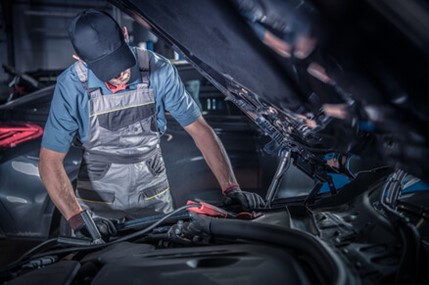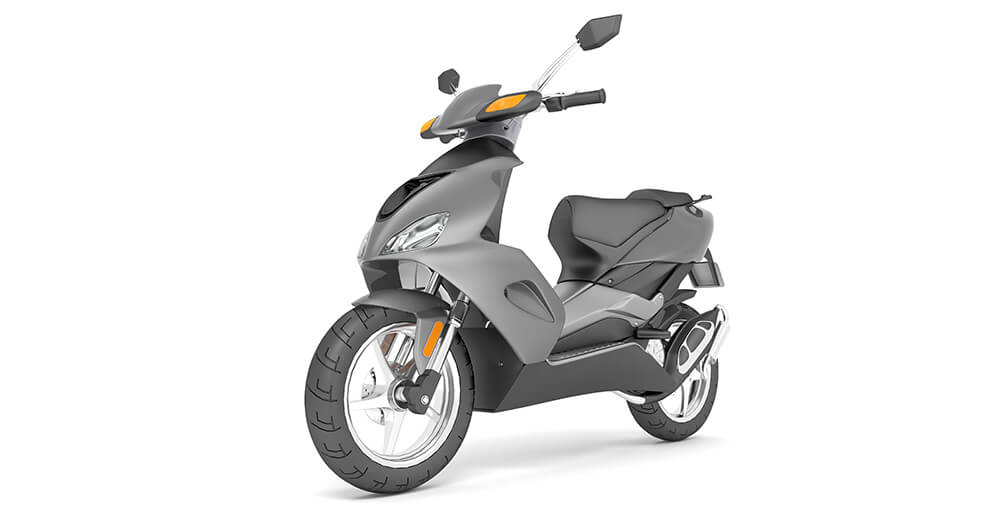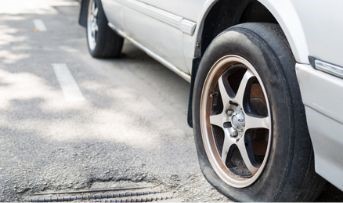General Insurance Blogs, Articles & Updates by - Magma HDI
Have us call you
- RENEW YOUR POLICY
- BUY NEW POLICY

If you’re struggling with productivity, a morning routine may be what you need
With the advent of the hustle culture and technology moving at an incredible pace, our lifestyles have been affected dramatically towards the unhealthy side. Our diets, sleep schedules, and working hours have seen a massive shift that has negatively impacted our health and relationships with ourselves and others. And this unhealthy switch has a massive effect on our work and productivity. While self-care has become an enormous part of our lives, it is now a must-do activity instead of just a habit we are supposed to inculcate in our daily routine.
Have you been feeling down and unfocused lately? Do you need help concentrating to carry out the menial tasks of the day? Well, mental health is a massive part of our lives today. You should contact trained professionals if you feel severe anxiety and other issues. But if you're struggling with productivity, a morning routine may be what you need!
This blog discusses how you can reform your lifestyle with a proper morning schedule and observe significant changes in your spirit and health.
1. Plan your day in advance:
Figuring out your day's schedule helps prepare you mentally and physically for getting all the work done. Monitoring the time to accomplish a particular task enables you to keep track and improve your efficiency and make space for other personal and professional things. A to-do list is a right way to go about structuring your day. You can allot time for these things according to your estimation and roughly note down the hours you will dedicate to a particular task from your list. This will help you stay on top of your productivity game.
2. A sound sleep:
A good night's sleep is essential. While several other pieces of research every day indicate different hours of sleep required by a certain age group, seven to eight hours is the fundamental need for a human body to function correctly. Ensuring a good night's sleep makes you feel fresh and ready for the next day. It helps you to be productive and complete all the tasks for the day.
3. Meditation and reading:
Meditation helps you connect with your inner self and calms your body. It enables you to strengthen your focus. Meditating every morning will help you calm your nerves and prepare for the day. It is very effective in dealing with anxiety and stress. Mental health professionals and physical trainers always recommend it as a part of your exercise and self-care regimen.
You can also set a target for reading which is a nourishment for your brain. You can either commit to reading ten pages daily and slowly increase. Or you can set a time limit, beginning with reading for ten to twenty minutes and then working your way up. This will help you improve your reading speed and boost your concentration, and eventually, you can develop a habit.
4. Move your body:
Any form of physical activity in the morning like stretching, yoga, and exercise will improve the blood circulation in your body and regulate hormone levels. Physical activities also help you structure your day, improve your metabolism and enhance your well-being. Your fitness journey would eventually lead you to healthier diet choices, thus making an enormous contribution to your lifestyle.
Some other elements you can introduce in building productivity include drinking one glass of water in the morning, eating a nutritional breakfast, breathing exercises, cleaning and organising your personal space and work desk, spending some time in nature without any gadgets, positive self-talk and affirmations, etc. The key is to formulate all these things into a routine and take it one day at a time.
Health is the most crucial aspect of our life. While we try our best to take care of our health, some unforeseeable circumstances can create an imbalance and adversely affect our health. To combat such incidents, you must explore different insurance options from multiple companies and choose the best health insurance policy for family.
Click HERE to learn more about the best health insurance policy for family and its benefits.
Disclaimer: The information provided above is for illustrative purposes only. To get more details, please refer to policy wordings and prospectus before purchasing a policy.

Planning to relocate to India as an NRI? Consider purchasing health insurance
Relocating to a new country is a thrilling and challenging experience that requires careful planning to ensure a smooth transition. If you're moving to India as a Non-Resident Indian (NRI), one of the most critical aspects to consider is your healthcare needs. While India has made significant strides in healthcare, medical costs can still be quite expensive. Having adequate health insurance coverage is essential to protect yourself and your family.
Here we'll discuss why purchasing health insurance is essential for NRIs planning to relocate to India.
1. Access to quality healthcare
One of the most significant advantages of purchasing health insurance is having access to quality healthcare. India has an excellent healthcare facilities system and skilled healthcare professionals, but these can be expensive. With health insurance, you can access the best hospitals and doctors without worrying about the high cost of medical treatment.
2. Comprehensive coverage
Health insurance offers comprehensive coverage for medical expenditures. It covers hospitalisation expenses, doctor's fees, diagnostic tests, and medication costs. NRIs can opt for individual or family floater policies to protect themselves and their dependents, ensuring everyone can access quality healthcare when needed.
3. Protection against medical emergencies
Medical emergencies come without warning, and they can be financially draining. With health insurance, you can protect yourself against such emergencies. Most health insurance policies cover critical illnesses and accidents, providing financial security and peace of mind.
4. Cost-effective
Health insurance is a cost-effective way to protect your health and your finances. Paying a small premium regularly ensures that you are covered for medical expenses that may arise in the future after relocating to India. Additionally, some health insurance policies offer tax benefits, which can help you save money on taxes.
5. Pre-existing conditions
If you have a pre-existing medical condition, it's essential to have health insurance coverage. Most health insurance policies cover pre-existing conditions, ensuring you have access to quality healthcare when needed. Declaring your pre-existing conditions when purchasing health insurance is crucial to avoid future disputes.
6. Cashless hospitalisation
One of the advantages of health insurance is cashless hospitalisation. In a medical emergency, you can access cashless treatment at any network hospital, ensuring that you receive the best possible care without worrying about the high cost of treatment. This feature especially benefits NRIs who may need access to more cash in India.
7. Tax benefits
Health insurance policies offer tax benefits under Section 80D of the Income Tax Act, making it an excellent investment for NRIs. You can claim deductions for the premium paid towards health insurance for yourself, your spouse, and your dependent children. This deduction can lower your overall tax liability, making it a wise financial decision.
8. Flexible coverage options
Health insurance policies offer flexible coverage options to suit your individual needs. You can choose the sum you want to insure based on your age, health condition, and family size. Many policies also offer additional coverage options such as critical illness, maternity, and overseas coverage, making it a versatile investment for NRIs.
9. Peace of mind
Purchasing health insurance provides peace of mind, knowing that you and your family are protected against any unforeseen medical expenses. With health insurance, you can focus on settling into your new life in India without worrying about the high cost of healthcare.
Moving to India as an NRI can be an exciting experience, but it's crucial to have adequate health insurance coverage to protect yourself and your family. Health insurance provides access to quality healthcare, comprehensive coverage, protection against medical emergencies, and peace of mind. Consider purchasing health insurance when relocating to India to ensure you have access to quality healthcare when needed.
Click HERE to learn more about the benefits of purchasing health insurance.
Disclaimer: The information provided above is for illustrative purposes only. To get more details, please refer to policy wordings and prospectus before purchasing a policy.

Here are ten easy tips to reduce bloating
Bloating can be a common but painful condition for some. We all know the feeling, the tender abdomen, and the stomach that looks a lot larger than usual. Bloating is a disorder that usually happens after overeating, eating something you are intolerant towards, or having too many fizzy drinks that result in a gas build-up.
However, bloating can also occur due to too much stress in your day-to-day life, which causes indigestion. This blog gives you some tips and tricks to get relief from bloating.
1. Try massaging the belly:
Bloating is usually a build-up of gas, which you can control by giving a gentle massage to your abdomen. This helps move the gas to the lower belly and relieve it. It’s best to follow the path of the large intestine for optimal results.
2. Drink that bottle of water:
Hydration is vital to most of the body’s functions. Drinking less water not only affects the kidneys but it has a significant impact on digestion too. Drinking water will make it much easier to pass stool, which will, in turn, help with your bloating. Also, the mucous lining of your stomach significantly improves from more hydration, so keep finishing that water bottle!
3. Reduce the consumption of fizzy drinks:
The consumption of fizzy drinks has increased drastically worldwide, which also brings digestive issues. Fizzy drinks are pumped with carbon dioxide, which gives the stomach a tough time. People have also replaced water in their households, which makes them even more dangerous.
4. Exercise:
In this technologically advanced world, sedentary lifestyles have become the norm making significant negative impacts on our overall health. Exercise relieves fluid retention as we sweat out sodium and helps move stool and gas out of our system. So, no matter how busy your schedule is, take time to indulge in some physical activity to relieve your abdomen.
5. Check for lactose intolerance, cut down on the dairy:
Approximately 65 percent of the world has a reduced tolerance to dairy products after infancy. So, it is no surprise that dairy products cause bloating in many people due to their inability to digest milk and milk products.
6. Drink your coffee:
Coffee can help make bowel movements regular and is therefore regarded as suitable for people who suffer from chronic bloating.
7. Avoid alcohol and other spirits:
Alcohol is fermented and is bad for your gut health. This might make you blow up like a balloon and cause severe discomfort. Using fizzy drinks to the mix makes the situation even worse.
8. Pop a peppermint capsule:
Peppermint is excellent for people suffering from Irritable Bowel Syndrome (IBS) but can also be used for indigestion and other gas–related issues. It is great for the gut as it helps relax the intestinal muscles, allowing stool to pass more easily. However, one should be careful and take these capsules only after reading the instructions. People with heartburn should skip this one.
9. Take a relaxing bath:
A warm bath or a shower can melt away all the stress of the day and make you feel light and breezy. This can reduce stress levels, which are a significant cause of indigestion. The warmth will also be relieving for a tender stomach.
10. Try to reduce your salt consumption:
Salt is a major cause of fluid retention and can cause bloating after an incredibly salty meal. Try cooking at home instead of dining out, and avoid fast food with salt and oils.
Bloating is highly uncomfortable and can ruin a day that otherwise was full of promises. Bloating can also be due to other medical reasons. If you notice regular bloating, contact a medical professional at the earliest to diagnose the issue. Additionally, consider purchasing health insurance that provides coverage against various illnesses to protect your health and look after your medical expenses. The right research and knowledge can help you find affordable health insurance plans that are soft on your pockets but best for your financial security.
Click HERE to learn more about affordable health insurance plans.
Disclaimer: The information provided above is for illustrative purposes only. To get more details, please refer to policy wordings and prospectus before purchasing a policy.

The importance of regular health check-ups for seniors in your house
Regular health check-ups are essential for everyone but become critical for seniors. People over 50 are more likely to develop chronic diseases because of unhealthy lifestyles, diets, genetics, and other reasons. The most common conditions in seniors include heart disease, cancer, COPD, arthritis, pulmonary disease, and memory loss. Buying health insurance in India for parents is a necessity you must pay attention to. Not only does it protect your finances from rising medical inflation, but it also offers preventive health checks.
A good health check for senior citizens covers various tests such as a kidney profile check-up, complete blood count test, fasting blood glucose test, thyroid profile check-up, abdomen and chest X-ray, and an ECG test. If you have senior parents or grandparents at your home, it is wise to provide regular check-ups to keep them healthy.
Here you can find more reasons to give your parents regular health check-ups.
1. Detect health problems early
Healthcare professionals are trained to detect different symptoms and suggest treatments accordingly. Doctors can help you identify health problems in seniors at the earliest. They can also refer them for requisite tests and send them to the right specialist. Most conditions, like diabetes and high blood pressure, don't result in symptoms at an early stage. However, doctors can identify these conditions by checking the senior's weight, blood sugar, blood pressure, and cholesterol levels.
2. Learn the risk of disease in seniors
During a prevention check, the doctor can find problems that may put your seniors at greater disease risk. Doctors also check the family's health history for inherited conditions like diabetes or cancer. If your seniors are more at risk of disease, doctors recommend a healthy diet, sleep, and fitness habits. Adopting these healthy habits prevents many diseases and ensures an enhanced quality of life.
3. Gain more control over chronic conditions
If your parents have long-term conditions like heart disease, diabetes, asthma, or arthritis, they will need regular care from the doctor. The healthcare provider will check in with your parents at each visit to ensure their condition is under control. They can also provide preventive measures like diet or medication to control the seniors' chronic conditions.
4. Treatment and cure chances increase
Besides preventing chronic disease, regular check-ups also help increase the effectiveness of treatment and recovery in seniors. With regular check-ups, doctors can provide better medication and lifestyle changes to manage symptoms and reduce risk factors for chronic diseases.
5. Save money by preventing costly medical services
People often spend lots of money on expensive medical treatments that can be avoided by developing healthy habits. If you don't want to spend money on costly medical services, you should take your parents to a clinic for regular health check-ups. Ensure they follow the doctor's advice regarding a healthy lifestyle and maintaining a healthy weight by paying attention to nutrition.
6. Build a relationship with a doctor
You and your parents can get to know your doctor better with each check-up. Building trust between doctor and patient is essential. It makes it easier for seniors to talk about personal subjects like drug or alcohol use, urinary tract health, etc., without any hesitation. Regular check-ups also help your doctor learn more about your seniors and advise the best health plan for them.
Regular health check-ups are a great way to assess your senior's health condition and detect any issues early. Also, getting health insurance in India for parents is essential, as it covers all medical expenses such as annual preventive health check-ups, domiciliary treatment, hospitalisation, and the costs of medicines.
Click HERE to buy health insurance in India for parents.
Disclaimer: The information provided above is for illustrative purposes only. To get more details, please refer to policy wordings and prospectus before purchasing a policy.

Why are boxy car designs trending among Indian car buyers?
In today's car market, you can find many models in different sizes, styles, and shapes. With each design, manufacturers are rolling out additional features to enhance safety, aesthetic appeal, functionality, etc. While you may choose designs and functions as per your preferences, safety is a non-negotiable feature. The best car insurance company in India offers comprehensive coverage, ensuring passenger safety at all times.
As per the latest auto trends, boxy car designs are becoming popular in India. These cars can be likened to passenger cars with features of off-road vehicles. Indians show a great interest in SUVs and hatchbacks, which has caused automakers to launch over 35 models in the last five years. Additionally, the most popular boxy car models are still flowing in.
Reasons why boxy car designs are in vogue
A significant reason driving demand for boxy car designs in India is the need for premium features. Car buyers are willing to spend more on their mode of travel and top-end vehicles with advanced features like connected technologies, sunroofs, and more space.
1. Seating capacity
Indian families usually have many members that need cars with more seating capacity. Boxy vehicles are more popular among large families. Small SUVs are 5-seaters, whereas most SUVs are 7-seaters. There are options to fit the requirements of different families. This makes boxy cars perceived more as family cars.
2. Sturdy build
The boxy car has rugged styling that gives it a glamorous on-road appearance. It’s tough nature also provides a bold stance on the street. Also, the driver can enjoy good handling, high-speed reliability, and riding quality.
3. Feature-rich
Most small SUVs have a wide range of features, such as a sunroof, a two-zone HVAC system, a turbocharged petrol engine, an automatic gearbox, and more top-notch features. SUVs also have other features like seven airbags and dual-zone climate control. The best advantage of owning a boxy car is the greater storage space for luggage.
4. Driver's high seating seat
India is known for its busy and narrow roads. SUVs have excellent visibility of the road ahead and have a high seating position. This feature lets the driver handle the vehicle more adequately through traffic jams and narrow streets.
5. High ground clearance
Boxy cars are equipped with high ground clearance, which makes them more suitable for operating on full-of-pothole roads. This feature also allows drivers to drive on waterlogged roads more easily than sedans.
6. More safety
Boxy cars have a high seating position and airbag features that provide safety to the driver and passenger physically and mentally. However, when a collision occurs, the driver and passenger must wear seat belts so that the airbag can work properly.
7. Reasonable price
A few years ago, boxy cars like SUVs were limited to the higher affluent class. However, now SUVs are perfect for all Indian car drivers' needs. Another thing that makes these boxy cars famous is their attractive price, discounts, and bank EMI options.
Boxy car suits large families and is a top choice for planning adventures like camping and road trips. If you are also interested in boxy car design, consider factors like capability, safety, performance, practicality, and reliability.
Also, consider choosing an insurance policy issued by the best car insurance company in India to ensure optimal coverage for your car. You can also get third-party liability and personal accident coverage with the right car insurance plan.
Click HERE to get insurance from the best car insurance company in India.
Disclaimer: The information provided above is for illustrative purposes only. To get more details, please refer to policy wordings and prospectus before purchasing a policy.

Budgeting fundamentals young adults must understand
Young adults are at a nascent stage of life, beginning to understand and bear life's responsibilities. It becomes important for them to understand budgeting fundamentals to adequately control their expenditure against what they earn. It will help them avoid suffering a money crunch situation or a deficit by spending more than they can earn during the budgeting period.
A life without budgeting is similar to a rudderless ship in the middle of an ocean. A budget is a perfect plan to structure our investments and ensure financial stability by estimating our probable income and expenditure. Let's understand a few budgeting fundamentals that can encourage young adults to become financially independent individuals capable of making fruitful investment decisions. When we talk about investments, insurance plays a vital role. Investing in a reliable general insurance company can be a good kick-start for young adults.
1. Know your income:
Young salaried adults should know their net income after considering several deductions and taxes. They should not focus on their total salary but on what they will get in hand during the budgeting period. This will help them not to overspend.
A young adult with an irregular income stream, such as a freelancer, a contractor, or a self-employed, should plan and chart his probable earnings over the budgeting period. They should also consider income from other sources, such as interest and dividend earnings, rental income, etc.
2. Know your expenditure:
Young adults should then divide their expenses into two parts- fixed and variable. They cannot avoid fixed expenses such as rent, telephone and electricity bills, EMIs, etc. However, they can control and trim their variable costs according to their income. They need to track and categorise such expenditures so that they know which expenditures to curtail and which to completely avoid.
3. Setting goals:
The next step in budgeting is to set realistic short-term and long-term goals. Short-term goals are the ones that will take a year or two to fulfill. Young adults may budget to set up an emergency fund. Long-term goals will take a longer time to accomplish. They may budget to invest a certain amount monthly in a mutual fund through the SIP route to secure their future or plan for their children's future education. They may also budget to buy insurance policies such as term, health, or life insurance.
4. Plan effectively:
Effective planning is the key to implementing any budget. Young adults should plan how to increase their income in the coming time and set spending limits for the expense category that can be controlled. They should understand the difference between necessities, comforts, and luxuries. While necessities are a must and cannot be curtailed, spending on comforts and luxuries can be controlled through proper planning.
5. Review regularly:
Young adults should review their budgets regularly. Income and expenditure may go up or down due to several reasons such as a salary raise, fulfillment of some goal, new ambition, change in taste and preferences, etc. They should adjust their budget accordingly so that it stays relevant.
Young adults must understand budgeting fundamentals and their importance in their lives. This will help them to stay aligned with their budget goals. They can switch to using cash as the preferred mode of payment in case they cannot control their spending when using plastic money.
Young adults are at a stage of life in which general insurance policies also start gaining importance. They should divert some portion of their income towards buying insurance policies, be it health insurance, home insurance, or any other type of insurance per their specific needs. Insurance will ensure their secure and financially stable future and cover their entire family in emergencies. The right general insurance company can benefit young adults by streamlining their finances with protection.
Click HERE to explore different insurance plans.
Disclaimer: The information provided above is for illustrative purposes only. To get more details, please refer to policy wordings and prospectus before purchasing a policy.

Why do different number plates have different colours?
Have you ever been stuck in traffic without recourse to pass your time? Most of the Indian population has experienced the same due to the ever-increasing number of cars on roads, poor driving etiquette, and ill-maintained roads. In such situations, looking around often helps find temporary things of interest.
In such situations, even mundane things can catch your eye. Have you noticed that some vehicles have different coloured number plates? However, if you have wondered why some vehicles have other coloured number plates and their significance, read on.
Understanding the layout of number plates
In FY 2019, India had 295 million registered vehicles. With a CAGR of 10% between 2007 and 2019, it is safe to assume that the pace of growth of registration has sustained, if not grown. Legal mandates have made it compulsory to buy motor insurance online and getting a vehicle registration number even before your car hits the road. To adhere to the process, knowing the layout of number plates is essential.
● The first two letters indicate the Union Territory or State where the vehicle is registered
● The following two digits denote the district RTO's sequential number
● The next section of up to 2 digits or letters reflects the series of numbers presently being allotted
● The last four digits are your car's unique registration number
You can find IND lasered under the Ashok Chakra emblem on the left. Underneath the number is a unique pin code for the number plate. The text is usually in black or white, depending on the plate's colour. This is the general format commonly used until the introduction of the BH series number plates.
Different number plate types and their meaning
1. White
This is the most prevalent type of number plate. You will be allotted a white number plate if you purchase a car for personal commute purposes. The numbers are lasered in black.
2. Yellow
Another common number plate colour is yellow, with the registration number etched in black. This indicates a commercial vehicle that may transport goods or ferry passengers. The regular documents required to be carried by drivers include motor insurance papers, a driver's licence, and a PUC certificate. Additionally, commercial drivers must have a permit that states their eligibility to carry out the same.
3. Green
The emergence of green number plates is a sign of shifting toward sustainability. These are assigned to electric vehicles of all kinds- two-wheelers, cars, buses, etc. The registration number is etched in white on these number plates. Unlike the distinction mentioned above regarding purpose, all-electric vehicles have green number plates irrespective of use.
4. Black
A black number plate indicates a vehicle has been registered for rental. Drivers do not require a commercial driving licence for these rented commercial vehicles.
5. Blue
Blue number plates with white lettering are rarely seen. They are used to indicate vehicles that belong to a foreign embassy or consulate. These are reserved for foreign diplomats and have unique registration numbers. Instead of the state code shown in the first two letters, the diplomat's country is displayed.
6. Red
Red number plates are for vehicles owned by the President or Governors of India. These number plates have a gold emblem of India instead of a registration number.
Vehicle registration is a mandatory process in India. Before you purchase a new vehicle, knowing what type of number plate to apply for is ideal. You may research more to get deeper insights and understand the colour system. Also, buy motor insurance online to keep your car safe from accidents. A comprehensive motor insurance acts as a safety net to avoid venting your pockets if your car demands repair and replacements.
Click HERE to buy motor insurance online.
Disclaimer: The information provided above is for illustrative purposes only. To get more details, please refer to policy wordings and prospectus before purchasing a policy.

With retro motorcycles trending, here are some classic features to look out for!
India is a country that has forever favoured 2-wheelers. With their cost-effectiveness, fuel efficiency, and ease of handling, the Indian 2-wheeler market will only grow multifold in the coming years! While manufacturers constantly launch new models that solve existing concerns in response to consumer feedback, what's classic never goes out of fashion.
One such model which is gaining popularity is Retro motorcycles. They are coming back in trend again! Apart from being a status symbol, various reasons have resulted in the popularity of retro bikes. They have been the favourite of Indians for many generations. People love riding these as they are classy, elegant, and highly durable.
Motorcycle enthusiasts prefer these retro motorcycles as they are suitable for varied terrains and long rides due to their sturdiness and comfort. Their additional safety features offer benefits similar to no other bike. Coupled with comprehensive bike insurance, you have a safe mode of a personal commute!
Despite the glitz around these classic bikes, buying your first retro bike as a beginner can be overwhelming. If you're confused about the features you should consider before purchasing a retro motorcycle, here's a quick guide to ease the process.
1. Longevity
Classic retro bikes are incredibly durable. Their quality justifies the hefty amount spent on these bikes. The vintage designs are built to last for years without hassles. Think of them as an investment in the long run, as they are heavy-duty and usually last for decades. Having a classy retro bike doubles the appeal of your parking area.
2. The comfort
These bikes come with comfy seats, an upright handlebar position for a straight riding posture, and uncluttered controls or switches. You can easily get the functions right and go along your way. They also have a high torque level and offer a pleasurable riding experience.
3. Improved engine
Engine power is essential to the biking experience. One of the greatest USPs of these bikes is their improved engines and loud revving thunder. You should always see if the bike you opt for has the latest engine and a high capacity. Also, look for shock absorbers and a secure braking system for efficient high-speed control and easy driving.
4. Practicality
Do not compromise on everyday functionality for the sake of aesthetics. Robust construction, wide tyres, and better ground clearance are required for multi-terrain use. Before purchasing a retro bike, you should keep these things in mind for the best motorcycling experience.
5. Colour options
Retro motorcycles are renowned for their classic designs and vibrant colours. Although it is a minor factor, it can contribute a lot to your style statement. You can either get them in monotone or dual shades.
Classic and retro motorcycles are incredibly well-known in India and beyond. Everyone loves owning one for themselves. It is a status symbol and a matter of pride for all. They appear vintage yet attract the youth! Hence, buying the best and most durable motorcycle for you is recommended. You can buy bike insurance for added protection to complement the safety it offers. This can protect you against the cost of damages from an accident and help preserve the value of your highly-valued retro motorbike.
Click HERE to buy bike insurance to safeguard your retro motorcycle.
Disclaimer: The information provided above is for illustrative purposes only. To get more details, please refer to policy wordings and prospectus before purchasing a policy.

With shared motorcycle services gaining popularity, run these checks before you ride one!
Motorcycles are a highly preferred mode of transport in India. While they are easily accessible, there continues to be a majority of the population that has second thoughts before buying them. Shared bike services have recognised the gap and mushroomed in response to market needs.
These short-term rental providers help reduce transport expenses in urban cities.
Despite their affordability, safety is a priority that cannot be compromised with these commute alternatives. Purchasing bike insurance online for your rented bike is a necessity to protect yourself from the cost of accidents. Additionally, running a comprehensive inspection can serve as an adequate preventive measure.
Here is a quick list of components to check before riding a rented bike.
1. Sound tyres
The most obvious component to inspect is the tyres. A safe ride needs to have well-maintained tyres and wheels. A glance will provide enough basis for the wear and tear of both elements. Multiple puncture signs, debris stuck in the ridges, deflated tubes, and worn tread depths are common concerns regarding tyres. For the inner wheel, closely evaluate the spokes' positioning to ensure safety.
2. Sturdy bike chassis
The general frame of the bike must be sturdy. A thorough check of all its essential functions will eventually give you an idea of the usage and condition of the motorcycle. Before leaving the facility with a bike, ensure you have tested its component adherence. A firm shake of the motorcycle will help make this clear. Rattling sounds are a sign of caution to look out for. The older the vehicle, the greater the sounds and the higher the risk of accidents.
3. Working brakes
Brakes are the safety net that can prevent accidents when coupled with riding expertise. A bike with failed brakes is a disaster waiting to happen that you must avoid. Ensure that you test the brakes with high priority. You must check the pressure required to engage the lever and the effective pace of braking. While bike owners often overlook it, bike renters must ensure that the front and rear brakes function flawlessly.
4. Check for any fluid leaks
Bikes do not appear as complex machines but are made of various parts. Many of these components require fluids that lubricate the inner bearings to ensure proper functioning. Some fluids essential for running your vehicle are fuel, clutch, radiator coolant, brake fluid, etc. While you may not know the exact location of each part, a quick check around the bike will expose any leaks. Also, check that these fluids are topped up to ensure optimal functioning.
5. Stands
An assumed to be non-integral part of a two-wheeler are its stands. Check the condition of both- the centre and side stand to ensure the bike is stable when parked. A proper chassis check will reveal any slack in the springs' tension or structural issues with the stands.
6. Indicators, horns, and lights
For a safe riding experience, giving clear indications while on the road is essential. By providing clarity, riders can communicate their intent clearly and prevent accidents. For ensuring smooth communication, the horn and indicators are critical. Test the functioning of indicators, horns, and lights.
Additionally, ensure that your signal reaches other riders. The head, tail, and brake lights deliver your indication. If you see any issues, notify the service provider immediately.
While shared bikes are extremely convenient modes of transport, riders and bike owners must inspect their two-wheelers properly before taking them for a ride. It is their responsibility to prioritise safety and derive value for their money. Additionally, riders and bike owners must consider purchasing bike insurance online to protect themselves against the financial cost of accidents.
Click HERE to buy bike insurance online.
Disclaimer: The information provided above is for illustrative purposes only. To get more details, please refer to policy wordings and prospectus before purchasing a policy.

Raising a claim for a scratch or a dent on your bike may not be the best move
In a country like India, where rash driving is very common, you must be extra careful about your actions on the road. You need to be familiar with all the traffic rules and regulations. It is because you endanger yourself, your co-passengers, and even the pedestrians on the road while driving. Following traffic rules saves you from unwanted damage and getting penalised. You should also have bike insurance to secure your motorcycle and finances in a crisis.
Although bike insurance is a good investment, what does it cover? Suppose you meet with a small accident. Is it okay to file a claim for minor dents or scratches? We will answer them all for you in this article.
Is it worth it to claim insurance for bike scratches and minor dents?
Bike insurance claims can be tricky. If you are new to the world of insurance, you will find it challenging to decipher everything. You may face difficulties filing a claim for something that is rightfully yours.
Before you file a claim, you must keep a few things in mind. The first is the extent of the damage done to your vehicle. The second is the type of policy that you have purchased. It determines the level of damage it covers.
With a comprehensive policy, you can file a claim for damages that occurred to your bike. However, if you have third-party insurance, the scenario will be different. In the case of third-party insurance, you will not get the cost for all the damages done to your bike as it covers the damages to a third party's vehicle.
So, for your comprehensive motor insurance policy, access the damage done to your bike and the extent of it. If you believe that the damages are beyond regular repair, you can file an insurance claim. However, you should not file the claim if you think the dents and scratches are repairable and will cost you nominal. In such a case, you must save the insurance claim for a future crisis. It is always better to be on the safer side!
What are the advantages of not claiming insurance for minor dents?
There are many hidden benefits of not claiming bike insurance for minor damages to your bike, including
● Low premium:
It is known that the premium will increase significantly when you claim insurance. It can be bothering for you to pay the increased premium after that. To avoid this, you should not claim minor damages as it will keep your finances in control, and you will enjoy a low premium.
● Lack of claim bonus:
The No Claim Bonus feature in bike insurance offers discounts to policyholders when renewing the policy for not filing a claim during the policy period. The discount increases for the years if you do not raise a claim.
Understanding the basics of bike insurance, such as coverage, inclusions, and future implications is a fundamental requirement before deciding to claim bike insurance. It is usually never worth claiming for minor dents as it can be less fruitful in the long run. Do your due diligence before making major financial decisions, such as purchasing bike insurance, raising claims, etc. Wisely utilise insurance benefits to ensure the best compensation for the damages incurred.
Click HERE to buy the best bike insurance in India.
Disclaimer: The information provided above is for illustrative purposes only. To get more details, please refer to policy wordings and prospectus before purchasing a policy.

Are you an off-road biking enthusiast? Consider purchasing these add-ons
Bikes are nothing short of an adventure on two wheels. While they have always been highly preferred in the Indian market due to their convenience, relative inexpensiveness, and ease of learning and riding, bikes are also doubling as a means of thrill providers over the last few decades.
With the varied topographical diversity in India, adrenalin seekers that enjoy motorbiking have found new joy in off-roading. While taking your bike on the road not commonly taken may give you momentary exhilaration, keeping your safety in mind before taking on such adventures is essential. Purchase a bike insurance policy that covers accidents resulting from such extreme sports.
Before getting started on your off-roading journey, consider purchasing these add-on covers to your bike insurance –
1. Engine protection:
The bike's engine is quite literally the heart of the machine. Ensuring it is in excellent condition is essential, especially when taking on challenging terrains. Since off-roading involves steep and rocky inclines, it puts tremendous pressure on your bike's engine. This makes it more likely to break down and leads to high engine repair costs. This add-on provides coverage for all expenses allied with engine repairs and maintenance.
2. Zero depreciation:
Wear and tear is a natural occurrence, and your bike is no exception. Usually, in case of raising a claim, the insurance company only admits a partial amount of the insured sum after factoring in the depreciation costs of the bike parts. However, buying a zero-depreciation cover can help you receive a higher claim amount than in the absence of such cover, making it easier to finance the cost of replacing bike components.
3. Theft of personal belongings:
Unlike regular riding, dirt biking requires special equipment that enhances the rider's safety. Such personal belongings are often expensive and require additional care to maintain. In case your riding gear gets stolen, a personal possessions cover can help you recover the insured sum or the cost of the stolen assets, providing peace of mind and financial security.
4. Roadside assistance:
Breakdowns may be frequent, even for regular bikes used for standard conveyance purposes on paved roads. Harsher terrains inevitably lead to greater chances of bike breakdowns due to multiple uncontrollable factors and mechanical failures. In such emergencies, it is necessary to have a backup plan to rely on. A roadside assistance cover provides reassurance of help in unforeseen conditions, making it a key requirement to purchase.
5. Outstation emergency cover:
The outstation emergency cover is necessary for off-road biking enthusiasts who enjoy long-distance biking adventures away from their residences. Generally, most bike insurance companies state the scope of coverage to be outside a 100-kilometre radius from the place of residence stated in the policy papers.
Can you buy specific bike insurance for your dirt biking adventures?
If you are a beginner to the sport, you may think of purchasing the above-stated add-on covers as a hassle and wonder why not buy an all-inclusive dirt biking insurance policy to protect your bike. Whether you intend to use a regular motorcycle for adventure sports or own a dirt bike, most insurance companies in India do not offer specific off-roading bike insurance. However, you may get comprehensive bike insurance that provides extensive coverage for your bike.
As the activity gains popularity, we expect the Indian insurance industry to adapt to the changing demand and provide suitable security cover for adventure activity. Until then, if you wish to take on the thrilling activity, we urge you to purchase the requisite add-on covers to make your bike insurance policy's coverage comprehensive for your needs.
Click HERE to buy bike insurance.
Disclaimer: The information provided above is for illustrative purposes only. To get more details, please refer to policy wordings and prospectus before purchasing a policy.

Here's how you can boost your brain power with the power of magnesium
Brain power is directly affected by several nutritional factors that enrich our body through the food we eat. Proper nutrition intake helps to boost our cognitive well-being. Our brain constitutes merely 2% of our body weight but consumes almost 20% of the overall energy utilisation. Hence, it is always searching for nutrition, and it becomes our duty to fulfill this need.
Is there any particular nutrient that can boost your brain power? You will be surprised to know that magnesium plays a significant role. Let us know more about it in detail.
*Note
It is crucial to invest in the best health insurance policy in India to avoid venting your pockets while dealing with treatments or medical emergencies.
1. Energy production
Magnesium produces unimpaired energy required by mitochondria, the powerhouse of cells. Magnesium also enhances the activities of the essential enzymes useful in energy production.
If energy production is not optimal, our brains may not function properly. There can be a negative impact on its cognitive powers. Hence, magnesium is essential in our body to facilitate energy production and boost our brain power.
2. Neuronal processes
Other than energy production, magnesium is important for neuronal processes too. It regulates neuro-transmitting signals in the brain. It is the key to the prime neurotransmitters- GABA and glutamate.
Magnesium also helps to maintain sufficient calcium content in the brain cells and regulates the activity of calcium channels. High magnesium levels in the brain can help enhance your memory and learning power. Also, it strengthens the process of synaptic plasticity, which can delay cognitive decline due to ageing.
An increase in magnesium levels in the brain may also increase the pace of neural stem cells production. It can promote neurogenesis in adulthood and improve the brain's adaptability to changing external environments, mood regulation, and cognitive flexibility. Magnesium can also help to maintain proper blood flow to your brain by helping to control oxidative stress and inflammation.
3. Brain decline
Various studies have proven that low magnesium levels can result in a decline in the brain's performance. People who have Alzheimer's disease come up with low levels of magnesium in their cerebrospinal fluid. Studies also show that people using magnesium oxide are less at risk of developing dementia.
Research also shows that magnesium plays a significant role in healing traumatic brain injuries. People treated with magnesium sulphate showed a favourable outcome and recovery within 12 hours. Studies have also proven that magnesium affects the functioning and health of a normal brain.
4. Magnesium-rich foods
Now you must be clear about the power of magnesium in boosting your brain power. But what are the foods that are rich in magnesium? Here's a complete list.
Dark chocolate, spinach, avocado, pumpkin seed, bananas, cashews, leafy green vegetables, whole grain, legumes, almonds, brown rice, black beans, yogurt, fish, and sunflower seed are some foods that are a rich source of magnesium.
Magnesium helps to boost your brain power and cognitive well-being. Increase your intake by consuming more food rich in magnesium. Magnesium is also important for several enzyme reactions impacting your bones, blood sugar, and nerves.
In addition to taking a magnesium-rich diet, you must buy the best health insurance policy in India that can protect you from unplanned financial burdens. Your health can deteriorate anytime, and you may require surgery. Health insurance will cover you in such instances. Do proper online and offline research and opt for the best health insurance policy in India that provides good coverage at the most reasonable premiums.
Click HERE to buy the best health insurance policy in India.
Disclaimer: The information provided above is for illustrative purposes only. To get more details, please refer to policy wordings and prospectus before purchasing a policy.

Can accidentally misfuelling your car be a potential threat
Motor insurance is a boon that provides vehicle owners security against the financial burden of mishaps that occur to their cars. While it offers several inclusions, acts classified as contributory negligence do not fall under the policy's scope of coverage.
One such act is misfuelling your vehicle, which unfortunately happens frequently. If you find yourself in such a situation, here's all you need to know.
Case 1: Potential dangers of petrol in a diesel car.
Gasoline in a diesel car is a solvent for low lubrication and could damage the fuel pump. Metal pieces from the broken pumps could cause more problems with the fuel delivery system.
What to do: Avoid turning the key and igniting the engine.
The tank must be emptied, with all tainted fuel removed and replaced with a new charge. You can only turn it on after that.
Case 2: Threats of diesel in a petrol car.
Because the diameter of the diesel fuel filler cannon is often larger than the slot of petrol cars, refuelling a petrol car with diesel fuel is uncommon. However, in such situations, the engine doesn't start, and the exhaust severely smokes while running.
The spark produced by spark plugs is what drives a petrol-powered car. Diesel can clog the candles and the fuel system when you fill it up and start the vehicle. It can lead to misfires, smoke, and possibly even a motor failure.
What to do: Don't turn on the ignition and refuel the tank.
Use a specialised additive that clears diesel traces from the fuel system if you fill the petrol tank with diesel in any amount. Furthermore, it matters how much diesel has dispersed throughout the car's internal components after entering the gasoline tank.
It is advised to do a complete tank drain and then fill the entire tank with gasoline. If less than 2 litres have been added, there will be no issues. Obtain assistance from a professional who can remove and clean the gasoline tank if the diesel content exceeds 5% of the tank capacity. Once completed, you can start the car and drive it further.
If your car is already running.
It is advised to drain the fuel tank and refill the fuel system with fresh gasoline before starting the car. If you're driving when you realise, stop as soon as possible. To eliminate the contaminated fuel, it is imperative to flush the tank. Replacement of the gasoline filter is essential in each scenario.
How can the risk be reduced?
No one purposefully fills their tank with the wrong fuel, yet many individuals do so even though the filler size varies for the two fuel types. The type of fuel used on each car is noted, typically on the tank cap and the filler cap as well. Before beginning to refuel, always double-check the type of fuel!
The repair cost may increase depending on how much-contaminated fuel is in the fuel system. You should always be careful to avoid such incidents, and if it does, you could incur significant repair costs.
One of your most valuable possessions, your car, needs to be protected because repairs are expensive. The best way to protect yourself is to purchase motor insurance, which offers several advantages that can increase your safety and safeguards your finances in the case of an accident.
Click HERE to buy motor insurance.
Disclaimer: The information provided above is for illustrative purposes only. To get more details, please refer to policy wordings and prospectus before purchasing a policy.

Ensure thrilling long rides without any aches by following these tips
Commuting by bike is a routine affair for millions of Indians around the length and breadth of the country. If you are a daily commuter and have to go through crowded, traffic-filled small lanes in India, a bike can be the best form of transportation.
Bikes can be great fun, even for long rides. However, the long journey can be tiring and cause body aches. Aches can spoil your remaining adventure and may dampen your high spirits about bike travel.
You can ensure thrilling long rides without any aches by following these tips.
1. Exercise
Long rides can cause severe backaches. Riding a bike puts extensive pressure on the core muscles because they bear your body weight. You need to strengthen your midsection and ensure that your spine stays strong. Several exercises strengthen your back, but you need to do them regularly, not just for a few days. There are some yoga asanas, too, that can help to strengthen your spine. Exercising will help preserve your core muscle strength and ensure your spine does not suffer undue pressure. It will benefit you immensely and prevent long-term health problems as well.
2. Correct posture
Incorrect posture while riding your bike can result in back pain, which even regular exercising cannot help. You should maintain a straight back during long bike rides. Line up your shoulders above your waist, and never sit in a hunching position. Most riders ignore their sitting posture and end up with back pain during long rides. Also, do not put extra weight on your back, such as a heavy backpack. Undue weight can also spoil your posture and cause back ache.
3. Rest occasionally
You must occasionally take a rest during a long ride on your bike. Continuously riding your bike without stopping can cause chronic injury. Stop frequently and get down from your bike. Try simple stretching exercises such as arching your back forward and backward, twisting your shoulders and arms, and leaning in front to touch the toes. It will relax your body and freshen your mind and spirit.
4. Give your hands a break too
The incorrect gripping style of the bike handle can result in hand aches. Your wrists should have about 10-15 degrees back-bend on the handle. Some bikes have very low handles, which can cause discomfort and pain, especially during long rides. You can always get your handle position adjusted by a mechanic if you feel it is too high or too low before commencing the long ride.
5. Good seat cushioning
Company-fitted bike seats may not have adequate cushioning. This can cause discomfort and backache during long bike rides. Get a good seat cover for your bike that has proper cushioning. You can get it customized and choose the cushioning level as per your choice and comfort.
Many bike enthusiasts love taking their bikes on long rides for a thrilling experience. Following the above tips will ensure that you truly enjoy your long ride without aches and discomfort during your journey.
A good 2 wheeler insurance policy is as critical for any rider as it ensures a comfortable long ride. It will provide you with financial coverage for an accident or damage. The insurance company will reimburse you for your bike’s current value if stolen. Moreover, having valid 2 wheeler insurance while riding your motorcycle is legally compulsory. So what are you waiting for? Go get your 2 wheeler insurance policy immediately!
Click HERE to buy a 2 wheeler insurance policy in just a few clicks.
Disclaimer: The information provided above is for illustrative purposes only. To get more details, please refer to policy wordings and prospectus before purchasing a policy.

Encountering these 3 situations warrants cancelling your bike insurance
Bike insurance is essential for every motorcycle owner to protect themselves from financial losses because of unfortunate events such as theft, damage, or accidents. Most people purchase bike insurance online as it saves time and offers them various options to compare and choose from. However, sometimes people encounter situations where they should consider cancelling their bike insurance to save unnecessary payments.
If you are selling your bike, moving abroad with your bike, or your bike is no longer in use, you can save unnecessary premiums just by cancelling your insurance policy.
By understanding these situations, bike owners can make informed decisions about cancelling their bike insurance policy when necessary. Without further ado, let's discuss these situations in detail.
1. Selling your bike
If you have sold your bike, you do not need to keep the insurance policy active. In such a scenario, you should cancel your bike insurance policy to avoid paying unnecessary premiums. You can easily cancel your bike insurance online by contacting your insurance provider.
2. Moving abroad
You must buy bike insurance in that country when moving abroad along with the bike. In such a situation, cancelling your existing bike insurance policy is advisable to save you from paying unnecessary premiums. Contact your insurance provider to cancel your policy, and they will guide you through the process.
3. The bike is no longer in use
You do not need to pay for bike insurance if your bike is no longer used. For instance, if you have switched to public transport or a car, you should cancel your bike insurance policy to save money.
The other probable reasons when you can cancel your bike insurance are;
● Not satisfied with the policy
If you are dissatisfied with your current bike insurance policy and have found a better one with more benefits and a lower premium, you can consider cancelling your existing policy. However, before cancelling, you should read the terms and conditions of your current policy to understand if there are any cancellation charges or penalties.
● High premium
If you are finding it difficult to pay the high premium of your bike insurance policy, consider cancelling it. However, before cancelling, you should compare policies from different insurance providers to find one that suits your budget.
● Reckless driving
Your insurance provider may cancel your policy if you have a history of reckless driving and have been involved in multiple accidents. In such a scenario, it is advisable to surrender your bike insurance policy and look for a new policy that suits your needs.
Bike insurance is a crucial aspect of bike ownership as it provides financial protection against any unforeseen events. However, there are certain situations where cancelling your bike insurance policy is the right decision. It is essential to remember that before cancelling your policy, you should read the terms and conditions of your policy to understand if there are any cancellation charges or penalties. By cancelling your bike insurance policy when necessary, you can save money and ensure you buy the right bike insurance online to fully meet your needs from the comfort of your home.
Click HERE to learn more about the benefits of purchasing bike insurance online.
Disclaimer: The information provided above is for illustrative purposes only. To get more details, please refer to policy wordings and prospectus before purchasing a policy.

Best beginner's tips for enjoying kayaking this summer holiday
Kayaking is one of the most exhilarating water sports activities one can indulge in during the summer holidays. It is an exciting way to explore the natural beauty of lakes, rivers, and oceans while exercising and enjoying the fresh air. However, for those who are new to the sport, it can be overwhelming to figure out where to start. Therefore, we have compiled a list of the best beginner tips to help you enjoy kayaking this summer holiday.
While kayaking is a fun and exciting activity, it also involves some risks, and it's essential to take precautions to ensure your safety. In addition to learning the basics of kayaking, it's necessary to understand the importance of wearing protective gear and obtaining a personal accident insurance policy before you hit the water.
With these factors in mind, let's understand some detailed pointers to help you make the most of your summer kayaking experience.
1. Choose the right type of kayak
Before you start kayaking, you must choose the right type of kayak for your skill level and the water you'll be kayaking on. Sit-on-top kayaks are an excellent option for beginners as they are stable and easy to use. They are also less likely to tip over, making them safer.
2. Wear appropriate clothing and gear
Kayaking can be a wet and messy experience, so wearing appropriate clothing and gear is essential. Wear a life jacket, a helmet, and appropriate footwear. Choose quick-drying, lightweight clothes that will keep you cool and comfortable in the water.
3. Learn the proper paddling technique
The paddling technique is essential for an enjoyable kayaking experience. Learn the proper technique from a qualified instructor or watch online tutorials. Good technique will help you conserve energy and prevent injuries.
4. Choose calm waters
Choosing calm waters with minimal currents and waves is essential for a beginner. Avoid kayaking in open water or rough conditions until you're confident in your abilities.
5. Bring a friend
Kayaking alone can be dangerous, especially for beginners. Bring a friend along for safety and to make the experience more enjoyable and memorable.
6. Stay hydrated
Kayaking can be physically demanding, and you can quickly dehydrate in the sun. Bring plenty of water or sports drinks to stay hydrated throughout your kayaking trip.
7. Check weather conditions
Before heading out for your kayaking trip, check the weather conditions. Avoid kayaking in stormy or high wind conditions, as these can make the water choppy and difficult to navigate.
8. Know your endurance
As a beginner, it's essential to know your limits and not push yourself too hard. Take frequent breaks, and don't overestimate your abilities. It's better to have a shorter, enjoyable kayaking trip than to push yourself too hard and have an awful experience.
9. Get a personal accident insurance policy
Consider getting a personal accident insurance policy before embarking on your kayaking adventure. This will protect you from any accidents or injuries during your kayaking trip. This policy can provide financial assistance for medical expenses and lost income due to injuries.
Kayaking can be incredibly fun and rewarding for anyone looking to enjoy the great outdoors this summer. By following the beginner's tips outlined above, you'll be able to get started with kayaking in no time while ensuring your safety and minimising the risks. Always prioritise your safety by wearing personal protective gear, obtaining a personal accident insurance policy to safeguard yourself against all the risks and dangers of the sport, and checking weather conditions before you hit the water. So, grab your paddle, wear your life jacket, and get ready to have fun on the water!
Click HERE to learn more about the benefits of purchasing a personal accident insurance policy.
Disclaimer: The information provided above is for illustrative purposes only. To get more details, please refer to policy wordings and prospectus before purchasing a policy.

Are you an older adult? Indulge in these sports to make you feel young again
Are you getting older and giving up on sports? This is a common phenomenon as the fear of injury increases with age and our fitness levels diminish. We hesitate to indulge in our favourite sport, badminton or cricket, with the fear of a muscle tear or a strained back.
But wait. Older adults should constantly engage in physical activities and sports to stay fit and active and enjoy a good social health score. Here are a few sports you should indulge in if you are an older adult and want to feel young again.
1. Golf
Golf is popular worldwide, and older adults can easily engage in it. It is a great stress reliever and improves your overall mental fitness. At the same time, it does not involve much running or physical effort, making it a great choice for older adults. Golf is known to improve blood circulation, which benefits your heart.
The older adults will also build a social circle while playing golf, which improves their emotional quotient. You should keep in mind that there is no pressure to perform well. Enjoy the time you spend outside in the sun in good company, and you will feel young again and light at heart.
2. Group exercises
Yes, group exercises are not just for the young ones but for older adults as well. Older adults can join group exercise classes, be it yoga, pilates, zumba, or some other dance form. They will start feeling young again even if they participate just a few times a week and not daily.
A group exercise will encourage older adults to match their pace with the group. It will keep them agile, fit, and active. These low-impact exercises can also benefit their respiratory system, muscle flexibility, and core balance. They are enjoyable and will also help them build a social circle.
3. Cycling
Cycling can be a great sport that can greatly benefit older adults. They don’t have to cycle at high speeds for long, as mild cycling can do the trick. Cycling improves cardiovascular functioning, immunity, and blood circulation and sharpens the mind. It can make you live longer and reduces the chances of hospital visits.
4. Doubles tennis/ badminton
Playing tennis or badminton in the singles format can be tough and draining for older adults. They can play doubles tennis or badminton to stay fit and agile at their own pace. These are fun sports, easy to play and practice. These sports will help strengthen their muscles, improve blood flow rate, and help them stay mentally fit. Older adults will feel young, active, and energetic once they start playing these sports in routine.
5. Billiards
Older adults can also engage in billiards as a sport. It is an indoor game; they need not sweat to play it. Also, it can be played with just 2-3 people. The sport requires moderate physical movement, sharpening the mind and improving concentration.
It is essential for older adults to engage in any of the above sports of their choice and feel young again. These sports will improve their muscle strength, blood circulation, balance, efficiency, and general mind and body fitness.
But sports also come with the risk of accidents. Hence, a personal accident policy is a must for everyone. It provides coverage and financial support for medical treatment due to an accident. You can easily browse several personal accident insurance online that the insurance companies offer, compare them, and choose the best among them conveniently at the click of a few buttons.
Click HERE to buy personal accident insurance online.
Disclaimer: The information provided above is for illustrative purposes only. To get more details, please refer to policy wordings and prospectus before purchasing a policy.

How embedded insurance is set to accelerate the pace of insurance penetration
There are numerous general insurance companies in India offering multiple insurance products. However, most of the population is opposed to purchasing these insurance safety instruments despite the dire need for long-term stability. Recognising the slack in demand for purchasing specific policies, general insurance companies in India have developed a new way to make insurance products more accessible.
Embedded insurance, also known as bundling insurance, is the latest method of partnering with a third-party brand and offering consumers complimentary insurance or with a nominal fee over the transition cost. It helps make insurance accessible by bundling it for customers.
However, if you wonder how embedded insurance can expand opportunities and build strong customer journeys, read on.
What is embedded insurance?
Embedded insurance enables a third-party provider to introduce innovative insurance products for customers. It provides consumers with more affordable, personalised, and relevant insurance. It also allows general insurance companies in India to access underserved and untapped markets.
How embedded insurance helps increase insurance penetration in India? Insurance penetration is calculated as a percentage of total premiums collected relative to the country's GDP. According to the IRDAI, the country's general insurance penetration is about 1%. India's insurance penetration is lower than in developed countries.
However, we anticipate an increase in insurance penetration due to embedded insurance.
Here's how embedded insurance transforms the insurance sector and increases insurance penetration.
1. Charging the untapped markets
This insurance allows insurers to access a new market. With embedded insurance, general insurance companies in India can provide microfinance companies with policies like personal accident insurance and more to target a specific audience. Insurers and third parties can expand the insurance sector's reach in India's underdeveloped markets with the help of embedded insurance. It allows them to reach the untapped rural market, increasing insurance penetration deeper in the country.
2. Innovating product offerings
Insurers can construct personalised and more relevant insurance policies using consumer data that was not recorded or digitised. Customers can also change the insurance policy's features, coverage, cost, etc., and discontinue them if they are no longer reasonable.
3. Enhanced customer experience
Embedded insurance boosts customer satisfaction, resulting in greater opportunities for general insurance companies in India to market their services and products. It also provides more customised coverage, allowing customers to change plans and premiums according to their needs. This way, it offers more significant benefits and value to the customers.
4. Low client acquisition costs
General insurance companies in India spend roughly 20% of their income on advertising to new clients. Embedded insurance decreases the churn rate by engaging policyholders at the right time in their journey. Also, the effective cost of customer acquisition is lower than other insurance.
5. Streamlined onboarding
Many people consider insurance an inconvenient procedure requiring a series of steps. Embedded insurance gives customers a streamlined issuing process, making insurance simple and inexpensive. This applies to the claim procedure too. The smooth operations of embedded insurance is a boon for Indians to invest in insurance massively.
Embedded insurance has much potential, but businesses must balance the efficiency and speed of business operations, regulatory compliance, and customer protection for this model to succeed.
Many general insurance companies in India are now integrating the internet of things (IoT), artificial intelligence (AI), machine learning, big data analytics, and other technologies to transform the insurance industry and deliver a hassle-free customer experience. While it will require time for adoption, it is a welcome move to increase penetration rates. Insurers must use the momentum and improve their dependability to gain consumer trust.
Click HERE to invest in a reliable general insurance policy.
Disclaimer: The information provided above is for illustrative purposes only. To get more details, please refer to policy wordings and prospectus before purchasing a policy.

Are extreme sports covered under personal accident insurance
Insurance is a financial product like no other. Upon payment of a meagre premium amount, it protects the insured person or asset against a contingent event involving a risk to its present or future value. While general, health and life insurance are relatively common products with a higher penetration rate in India, personal accident insurance online lags far behind.
While this may be attributed to the lack of awareness, it is straightforward why the product is required. Accidents are uncertainties that can occur in any setting, whether travelling, commuting, or at work. Since you cannot eliminate the risk of accidents, purchasing personal accident insurance online is essential to protect yourself against hospitalisation costs and other expenses resulting from an accident.
The limited awareness regarding personal accident insurance is also only partially reliable due to the misconceptions surrounding the product. While its coverage to the extent of travel accidents is commonly known, there are several questions surrounding its scope of coverage for adventure sports.
Find out whether adventure sports are covered by personal accident insurance online.
Defining adventure sports.
Adventure sports are easy to define in lay terms but are described differently by every insurer. It includes sports that involve contact, extreme speed, technical gear, and extremely high levels of risk. As the name states, these sports have a considerably high-risk grade, making most insurers hesitant to cover them. Common extreme sports include skydiving, skiing, rappelling, mountaineering, etc.
Generally, irrespective of the type of insurance- general or non-general, most insurers do not offer coverage for adventure sports due to the intensity of the activities.
Why should you check for adventure sports inclusion before participating?
The thrill of adventure is second to none, and the addition of multiple uncontrollable factors only adds to the experience for those who seek an adrenaline rush. However, one must always ensure to protect themself from potential accidents before participating in such sports for the following reasons –
1. Hospitalisation coverage:
With medical inflation on the rise, covering any possible medical expenses, including those arising from adventure sports, is prudent. Considering the high-risk profile of these sports, it is always better to be ready for the worst and prepare a financial net that shoulders the burden of such costs.
2. Allied perks:
Personal accident insurance online offers related allowances such as a daily cash allowance, transportation, and more. This reduces the strain on your finances during your period of hospitalisation or any inactivity as an earning member.
3. Mental peace:
The most significant benefit of inclusion is the peace of mind to engage in activities of your choice. You don’t have to worry about the consequences due to the existence of a safety net for your finances.
Does personal accident insurance online cover extreme sports?
At face value, one may assume that personal accident insurance online would offer extreme sports coverage. Most insurers in India presently do not include accidents caused while engaging in such sports within the scope of the policy.
However, if you want coverage against such risks, some insurance companies offer comprehensive accidental coverage across all terrains and destinations. It may take additional effort to discover such insurers amid all those that exclude such accidents. Here are a few factors you should consider before purchasing a policy from such a provider:
1. The extent of sports covered- land, air, water, etc.
2. Provision of immediate medical assistance
3. Customisation of a plan as per your adventure needs
4. Active policy period
Despite the exclusion of extreme sports by most insurers, personal accident insurance online is an essential requirement that provides financial assistance when you are only partially covered by your term or health insurance policy alone. We encourage you to consider purchasing personal accident insurance online to cover the other form of accidents and your risk exposure.
Click HERE to buy personal accident insurance online.
Disclaimer: The information provided above is for illustrative purposes only. To get more details, please refer to policy wordings and prospectus before purchasing a policy.

How to adjust the driver’s seat properly to ensure optimal posture and visibility
Driving is a highly responsible task that requires a lot of attention and focus. Even the slightest distraction can lead to an accident which could be extremely dangerous and fatal.
So, it is recommended to be familiar with all the functions of the vehicle and drive sensibly. But did you know that the position of your seat and posture also play a significant role in your driving? You should always adjust your driver's seat for the best driving visibility. It should also ensure a good posture to avoid fatigue later. A good posture also ensures you are saved from injuries in an accident.
If you are wondering how to get optimal driving posture, we have you covered. This article will list all the ways to help you achieve the best driving posture.
Also, you should get the online motor insurance renewal on time to have additional protection and avoid trouble for your vehicle later. It can save you time, energy, effort, and hassles
How to maintain the best posture while driving?
Whenever you start driving a car, you should adjust the driver's seat according to your comfort and convenience. If you're driving someone else's car, it becomes more important to adjust your seat. If you fail to do so, you can get musculoskeletal disorders (MSDs) due to bad posture. A good posture also ensures that you don't get exhausted while driving. To adjust the driver's seat, consider the following:
1. Adjust the height of the seat
The height of the driver's seat needs to be appropriately adjusted to increase visibility while you drive. You need to adjust the seat according to your height so that you do not bend over to get the view properly. Moreover, there should be a minimum gap of about five fingers between the head of the seat and the roof of the car.
2. Maintain seat distance
The distance between the seat and the steering wheel is of prime importance. You cannot see the view correctly if it is too far away and requires bending over to reach the steering wheel. The seat should be positioned in a way that you can reach the steering wheel and the pedals effortlessly. This reduces the reaction time and helps you navigate the road well.
3. Maintain the backrest of the seat
Although it may not seem important, the backrest plays an important role while adjusting your driver's seat. The backrest ensures optimal comfort while driving. The backrest should be as vertical as possible.
4. Adjust the headrest of the seat
The headrest can serve as a great safety tool while dealing with accidents. It provides more protection to the head and saves it from injuries. You need to adjust the position of the headrest in a way that it protects your head in case of a sudden impact. You can also position a bit above your head for more protection.
These are only some suggestions by which you can get the best out of your driving experience. Lack of proper road visibility while driving can make it difficult for the driver to get judgement while making turns. These small measures will help you maintain a good posture and see clearly on the road. Make these adjustments in your driver's seat and savour the joy of a comfortable car journey. You should also get online motor insurance renewal done regularly for added protection.
Click HERE to get online motor insurance renewal.
Disclaimer: The information provided above is for illustrative purposes only. To get more details, please refer to policy wordings and prospectus before purchasing a policy.

Here's how you can treat cracked heels at home
Cracked heels are one of the most frequent and concerning foot problems, especially during the winters. It can happen to adults and children, although it tends to impact women more frequently than men.
Most individuals don't take broken heels seriously. Going barefoot may be uncomfortable as heel cracks occasionally go quite deep and hurt. Read on to find out the best home remedies and ways to keep your heels from getting cracked.
You can use home ingredients in simple cures for cracked heels:
We constantly take care of our faces, hands, and nails, but for some reason, we frequently overlook our feet. Additionally, they are more likely to get dry and cracked when wearing slippers or other footwear that exposes the feet.
Here are a few home-based cures for cracked heels that work quickly
1. Rose and milk for a deep conditioner:
This treatment will work like magic for people with painful, cracked heels. Take a small tub and fill it with warm water before adding half a cup of milk. Include a few rose petals and three to four neem leaves. Add a teaspoon of seed oil to the tub. If you have any essential oils, add a couple of drops. Spend 20 minutes soaking your feet, then gently scrub them to clear off the dead cells.
2. Oil massage:
Take one teaspoon of castor, olive, and almond oils and massage your heels with the mixture of these healing oils. Try moisturising your heels to help the oil soak properly. Wear socks and complete this technique right before bed. Your cracked heels will be healed and soft by overnight dampness.
3. Honey and banana moisturiser:
You should mix a teaspoon of honey and a small banana in a bowl. Achieve a liquid-like consistency before applying the paste to your heels. Keep it for 20 to 30 minutes, then rinse it with warm water. After patting your feet dry, apply your moisturiser. Vitamins A, C, and B6 are abundant in bananas, making them a natural moisturiser. Honey helps hydrate your skin and provides moisture to the skin's outer layers
4. Using a pumice stone and salt:
Pumice stone is used in this cure. Just add a few drops of olive oil to a spoonful of salt. Apply this scrub to your cracked heels, then scrub them gently with a pumice stone. Rub for another 20 to 30 seconds before washing with soap and water.
Caution:
If a medical disease is the cause of your cracked heels, do not attempt to treat it on your own. It could be necessary to receive specialised care from a podiatrist (foot doctor). No matter your medical history, a podiatrist should also look at cracked heels that are very bad. The doctor will recommend the appropriate course of action for your circumstances.
In the end, it can be hard to take care of heels, especially if you live in a dry area where they tend to crack. A lack of nutrients, diabetes, or atopic dermatitis may also cause cracked heels. The borders and soles of your feet may feel flaky and crusty when they become dry. These cracked skin symptoms can quickly disappear if you take good care of them by washing, moisturising, and wearing socks. Shea butter, coconut oil, olive oil, and honey are a few natural solutions for cracked heels. If these self-care solutions do not work for you, you must visit a doctor.
It is crucial to prioritise your health and ensure your well-being. Healthcare costs associated with sickness or accidents are covered by medical insurance. Your health insurance covers the costs of paying for your hospital bills or medical care directly. You can make online health insurance purchases conveniently with a hassle-free process.
Click HERE to buy an online health insurance plan.
Disclaimer: The information provided above is for illustrative purposes only. To get more details, please refer to policy wordings and prospectus before purchasing a policy.

Five best tips to deal with auto mechanics
Buying a vehicle is a significant milestone in the lives of most people. However, it is a depreciating asset that requires much care to maintain. Irrespective of how well you drive, your car is bound to need some repair and maintenance at regular intervals by an expert and professional auto mechanic.
Most people get intimidated by a trip to the auto mechanic from the fear of the high prices and a lack of general understanding of the auto mechanics. Purchasing car insurance India is the first step to ensuring your vehicle is always protected.
When it comes to dealing with auto mechanics, following these five simple tips will ensure that you have a stress-free visit where you understand the costs and advice of the professionals.
1. Be prepared to communicate:
Communication is the most crucial aspect of any problem-resolution situation. You must be aware of any problems you wish to get checked. You don't need fancy jargon to explain the issue; as experts, a general idea is enough to give them an understanding of the underlying issue. You must be prepared to express what you expect- a regular maintenance check or component-specific troubleshooting.
2. Ask relevant questions:
Another major mistake is not asking questions. They may use jargon and quote estimates that you may not understand. Do not shy away from asking for clarifications. We do not recommend hovering around the mechanics. Still, it is justifiable to ask for estimates relating to costs, tips to prevent the problem from recurring, and help for other allied issues.
3. Read up on your car:
Knowing your car's make, features, and performing abilities allow you to understand the standard performance of the vehicle. Only then can you identify any variance that may require the inspection of a professional mechanic.
We recommend reading the car manual thoroughly and keeping information related to its identification number and component-related specifications handy in case it is required when scheduling a servicing appointment.
4. Request for original components from the manufacturers:
Buying a car is expensive, and any allied costs are just as expensive. Repairs and replacements can be pocket draining and are periodically required to keep your vehicle in its best shape. However, don't settle for replacing original components with copies made of inferior quality materials to minimise the bill.
Since regular repair costs are not included in car insurance India, the price of original components will inevitably have to be paid from your pocket.
However, using inferior substitutes will adversely impact your vehicle's performance and safety, putting your life at risk. Therefore, it is essential to request the mechanic to use original components to maintain the safety of your car.
5. Be available to approve further repairs:
In most cases, as mechanics work on the vehicle, they find other issues relatively more minor than the issue they are resolving presently. In such situations, they contact the owner to inform and ask for approval of comprehensive repairs. If you are unavailable at such times, the issue will magnify and cause concern.
If your car is at the garage and you get a call from the mechanic, it is suggested to respond at the earliest to get further updates that can improve the functioning of your vehicle.
Interacting with auto mechanics can be challenging, but it is a routine check you cannot skip, which is as crucial as purchasing car insurance India. However, dealing with auto mechanics can be simplified using our easy steps to get insight and the most value for your money.
Click HERE to buy car insurance India.
Disclaimer: The information provided above is for illustrative purposes only. To get more details, please refer to policy wordings and prospectus before purchasing a policy.

The weather seems to be perfect for a car drive, but your vehicle is refraining from starting, ever ben in such a situation?
Yes, we understand your problems, and the struggle is real when it comes to cars that stop suddenly, giving no hints of starting.
It can be a real deal when your lovely ride stops in the middle of a road and deny your orders to start. Having a car that stops suddenly can lead you to grave danger, especially when you are outside and need to go somewhere.
Interestingly, as easy as it is for your car not to start, similarly, there might be a principal reason behind the same. Therefore, let’s have a look at four common reasons why your car is not starting.
● Your timing belt is the real problem:
For those of you who don’t know what a timing belt is, it is an essential part of the car that is responsible for its effective running and performance. Your timing belt inside the vehicle is the primary reason why it keeps running and adapts to speed. Yes, gears do play a significant role, but the timing belt is what ensures that the engine’s valves open and close at the proper interval.
Therefore, your timing belt can be one of the most common reasons why your car has become idle and fails to start. A significant reason behind the same can be that the valves inside the timing belt and the pistons are not meeting each other at a said interval, failing to give you efficient results and movement.
Moreover, your timing belt is the major part that you should look after whenever you go for servicing. Having a timing belt that fails to keep up with the systematic opening and closing of the valves can lead to harmful damage to the engine. It is always advisable for you to change your timing belt at a regular interval of every 60,000 miles or five years (whichever is earlier).
● Your alternator might be the cause:
An alternator is that essential part of your car that is responsible for the effective functioning of all the electrical pieces of equipment that function inside your car. Its most significant function is to start the spark plug and essentially provide it with the spark that is responsible for the running of your engine.
Besides the successful starting of your engine, a failed alternator can also be the cause behind the failure of other necessary parts of your car. It is also linked with the plugs that power the headlight and therefore, you need to keep a check on your alternator as well, in case your car fails to start.
● Your battery might be corroded:
It is no hidden fact that cars perform majorly due to the presence of a battery inside it. The battery is responsible for running all the electric-based components of your vehicle and also plays a significant role in igniting your engine.
Corrosion on your battery can be serious trouble for you as it is like rust and will ultimately end up waiting away your car’s battery beside the other significant parts that are developed out of iron. We suggest you always keep a check on the health of your battery and its corrosion, every time you take it to a service centre.
● Are you sure your air filter isn’t clogged?
Similar to the other necessary elements of your car, the air filter might also be the cause that is failing your vehicle to start. An air filter plays a significant role in keeping up with the excellent health of the drivetrain of the car. It filters out all the harmful elements like dust particles to keep up with the smooth functioning of your vehicle.
An air filter is essential for your car to your car 'breathe'. A clogged air filter might also pose serious damage to the blockage of the exhaust pipe, leaving your vehicle to fail from the start.

How to take care of your car during the winter season?
With the onset of the winter months, the mercury drops, and so does the efficiency of your car if you do not maintain it well. Considering, you have invested a lot of money in buying your car and have chosen the best company to buy private car insurance in India and what not? So why neglect it during the chilly time of the year?
Cars require year-round maintenance to provide a smooth driving experience to the owner. After all, who wouldn't want that, right? Therefore, the following guidelines are prepared to guide you on how to take care of your car during the winter season:
● Heaters - Although a major part of India does not witness extreme cold weather during the winters, occasional chilly winds and low temperatures can tempt people to use the heaters in their car. What would be better than getting a good amount of heat after being outside in the cold for too long? That's why keeping a check on the heating system inside the car is essential.
●Starting the car - There is a general belief that the engine takes longer to warm up in the winter due to the surrounding low temperatures. Up to a certain extent, this is true. That's why people leave their car engine running for a while before driving. But that does not help much. The engine warms up after you drive, so it is best to take it out at regular intervals. As a result, you can make sure that the fluids are moving around efficiently, and the condition of the car does not take a hit in the cold weather.
●Fuel tank - If you live in extremely cold areas like those in the North which tend to receive snowfall, you must always keep your fuel tank full. If petrol or diesel is filled enough, the accumulated water can be prevented from freezing inside the tank, thereby saving your car from potential fuel damage.
●Engine oil - Engine failure is a common problem during the cold months. For the enhanced performance of your car, check the manuals that came along with it and use the mentioned engine oil so that the chances of any mishaps decrease. Also, maintain a certain minimum limit of oil and ensure that oil does not reduce past that limit.
● Windshield wipers - Apart from engine oil, windscreen fluid is something you need to keep full. Due to fog or light snow, the visibility of the road ahead of your car decreases. If your windshield is not clear either, you will face a tough time driving. That is why we recommend maintaining the cleaning fluid as well as the proper working condition of the wipers.
●
Tyre checking - A lot of people might be unaware of this fact, but tires need to be changed with the weather. Especially in the northern parts where temperatures tend to drop to an extreme. Winter tires are built in such a way that they remain firm to the ground and maintain stability even in low temperatures. Even if there is no snow, these tires provide ease and smoothness in situations like applying brakes and taking a turn on the road. Also, ensuring the air pressure of the tires is a wise decision as driving around with less pressure can lead to premature wearing out and chances of accidents or collisions increase.
●
Servicing - If you have little or no knowledge of how to maintain your car during the winter, just contact the authorized service centres of the company or other trusted service providers that can take away your burden and ensure the good condition of your vehicle. This way you can attain a feeling of satisfaction that any problems existing already would be taken care of and further possible damage can be avoided. While a lot can be done, sometimes the breakdown of a car is inevitable. In such cases, availing private car insurance in India will help in keeping the expenses in control.

Getting your health insurance is as easy as just a few clicks online
For today’s generation, long working hours, irregular sleep schedules, take-out meals, and an unhealthy lifestyle are becoming the new normal, impacting their everyday lives. An evident proof is an increased need for medical attention, which makes health insurance an obvious necessity.
With the 5G advancement of the mobile network, we trust the internet to provide us with faster and accurate information about everything, including health. Fortunately, so do the majority of health insurers. They rely upon the internet to offer a convenient, cost-effective, fast, and secure platform for their customers to buy online health insurance.
Why is online health insurance better? People still hesitate with the idea of online money transactions due to the possibility of fraud. But, this doubt holds no good if you are transacting on official websites of reputed insurance companies. Plus, the multitude of benefits that online policy portals bring is impressive. You get a better level of transparency than what any agent can provide you. You can also compare many websites for online health insurance before you finalise one.
The internet takes the whole idea of saving time to the next level. A few minutes spent online comparing different policies and their features is more convenient than visiting agents.
Health insurance companies are offering online buyers with exciting incentives to encourage more online health insurance purchases. As you buy directly with the insurance company, they save on intermediary costs and commissions to the agents. Therefore, online health insurance works out to be significantly lower.
Things to consider while buying an online health insurance. The most popular insurance isn’t necessarily the most appropriate one. The requirements and expectations of every person from their health insurance differ. To find the best plan for you and your family, consider the following factors:
• The number of members in your family that you want to insure
• Their age, diseases they suffer from, or if they frequently require medical attention
• The place you live, and the health factors associated with that place
• Your average medical expense
• The expected amount of cover
Note – The premium you pay is based on your current financial situation and family income.
How to buy health insurance online?
1. Visit the website of the desired insurance company.
2. Enter your requirements and the personal information of you and your family.
3. You will receive multiple quotes. Select the most suitable for you.
4. Enter your account details and make the payments of the required amount.
5. You will receive confirmation and the details of your policy via email.
6. Congratulations, you are now insured.
The best insurance agencies provide complete transparency so that customers make informed purchases. In addition, insurers strive to facilitate the best plans, give a shedload of options and a hassle-free experience by integrating the latest technology.
Often people make the mistake of buying the same policies as recommended by their friends and families. This may create financial stress on your family. Always have the right due diligence because your lack of knowledge might prevent you from enjoying all the features of the said policy.
With several promising technologies to enhance consumers' use and experience, take advantage of picking out perfect online health insurance for you and your family.
Know more about the Health Insurances available, click here…

If you are a travel enthusiast, you must buy personal accident insurance
Travel is like hitting a reset on the mundane flow of life. It is a breath of fresh air a amid hectic schedule involving tedious work. Refocusing efforts on personal growth rather than material success to prevent burnout and enhance productivity has allowed young professionals to take holiday breaks, explore the world to develop new perspectives, and take on new challenges.
While travel opens up a new world of possibilities, cultures, and experiences, one should never neglect uncertainties. Accidents are an uncertainty in life that one must always prepare for. Often forsaken since they are rare occurrences, irrespective of scale, they leave the victim with pain, financial burdens, and sometimes, lifetime disabilities.
Although you can't prevent accidents, you can be prepared and protect yourself against allied financial losses by buying personal accident insurance India. If you are an avid traveller, here's why you should consider purchasing personal accident insurance India before setting on your next journey.
What is personal accident insurance India?
The severity of accidents is often undermined due to their infrequency. However, irrespective of the cause of the accident, they may lead to accidental deaths, bodily injuries, or disabilities. Personal accident insurance India seeks to insure the policyholder against the financial losses arising from specific accidents that health and life insurance exclude.
Why should travellers purchase personal accident insurance India?
1. Stress-free travel: Exploring new lands and getting a taste of new experiences is best enjoyed without additional stress. Personal accident insurance India protects against accidents you may encounter while on your globe-trotting adventure. Check the fine print of your policy to ensure that your insurer covers accidents occurring abroad. If not, make sure you buy additional specific coverage for the same.
2. Medical compensation:
With medical inflation reaching record heights, healthcare services are costly across the globe. Depending on your preferred destination, you may have to shell out more if you need medical attention due to an accident. Personal accident insurance India covers hospitalisation and allied medical expenses, lifting the financial burden from your shoulders.
3. Additional benefits:
Apart from the medical compensation offered to the policyholder, their family can avail of family transportation allowance, children's education allowance, loan protection services, etc., to shift the burden from the policyholder.
Types of personal accident policy coverage.
1. Accidental death cover:
In case of the insured's accidental death, the nominee receives 100% of the total insured sum stated in the policy.
2. Permanent partial disability cover:
This insurance plan acknowledges disabilities that limit the functioning of the person. For partial disabilities like the loss of specific senses or body parts, you can claim up to 100% of the insured sum.
3. Permanent total disability cover:
Accidents that lead to the loss of essential body parts like limbs that directly impact the insured's ability to return to normal activities make the nominee/policyholder eligible to claim the assured sum.
4. Temporary total disability cover:
Where accidents impair the policyholder's ability to return to regular activities temporarily, the insurer pays a specified sum during the rehabilitation period in the form of a daily or weekly allowance to meet EMI payments, general living expenses, etc.
Exclusions of personal accident insurance.
Before purchasing personal accident insurance India, you must be aware of some of the main exclusions not covered by the policy:
● Natural death
● Pre-existing disability or injury
● Suicide or self-injuries
● Influence of intoxicants
● Acts of terrorism
● Engaging in criminal activities
Encountering an accident is not predictable. Purchasing personal accident insurance protects the policyholder against many accidents, including travel accidents. To protect yourself and your loved ones from unknown risks and travel stress-free, buy personal accident insurance India at the earliest from your preferred insurer!
Click HERE to buy personal accident insurance India policy.
Disclaimer: The information provided above is for illustrative purposes only. To get more details, please refer to policy wordings and prospectus before purchasing a policy.

All You Need to Know About the COVID-19 Vaccines
COVID-19 vaccines strengthen our immune system, and help it recognize and combat the coronavirus. The type and frequency of doses vary for different vaccines, however, beneficiaries are advised to take two shots of vaccines currently available in the country. Post vaccination, it generally takes a minimum of two weeks for anyone to build immunity against the virus.
Key Information and COVID-19 Vaccine Advisory:
- From 1st April 2021, all individuals over the age of 45 (irrespective of co-morbidities or pre-medical conditions) are eligible for the COVID-19 vaccine.
- Beneficiaries are requested to complete all prescribed doses of the vaccine.
- As per medical experts, post-vaccination effects (nausea, mild fever being the most common) are normal.
- Even after vaccination, all safety measures for COVID-19 are to be strictly followed at all times, including social distancing and wearing masks.
- The duration for which the COVID-19 vaccines are effective and its efficacy against the new strains of the virus is still unknown. Hence, it is absolutely essential to not let our guards down.
- We urge you to not be misled by fake vaccine marketing / promotions, as it is not available in open markets yet.
- Do not attend a vaccination appointment if you are self-isolating, or awaiting COVID-19 test results, or are unwell.
- Research efforts are ongoing for knowing how many people should get vaccinated to attain herd immunity (which means enough people being vaccinated making it tough for coronavirus to spread from person to person). Hence, rumors about herd immunity being already attained, should strictly be ignored.
- To know more about the vaccines, please download the CoWIN App, or log on to www.cowin.gov.in. You can also visit the Ministry of Health and Family Welfare (MoHFW) website (www.mohfw.gov.in) for regular updates about COVID-19.
- For any queries, call the Government helpline number 1075 or +91 11-23978046.
Cost and Availability of COVID-19 Vaccine:
- Vaccines are available at different government hospitals for free and at private hospitals at a price of INR 250 per dose.
- The COVID-19 vaccination providers cannot deny any individual above the age of 45 to get themselves vaccinated, except for reasons best known to medical practitioners.
- The government is currently working on making the vaccines widely available for everyone at no cost in the coming months.

Got a salary hike? Four things you must do after getting an increment!
Ever imagined what the three magical words for people with jobs are? It has to be, “Salary got credited”. But the actual happiness comes in when you get an increment in your current salary. Getting a salary raise after years of hard work is a significant milestone in life. After constantly working towards achieving your goals, earning a salary hike is a moment to celebrate, even if it’s small.
Once your source of income increases, your expenses also go up simultaneously. In addition to this, your taxes inflate too. Unless you have a proper financial plan, things might take a toll. But, not to worry, here are a few essential steps that you can implement after getting a salary increment.
1. Clear all your debts – no more instalment reminders:
Before you start spending more, it is important to clear the outstanding dues. If you plan to purchase something new on credit card or instalment, you must clear your loans or ongoing EMI. This will ensure that you don’t end up in any financial burden or unnecessary late payment on your existing loans. Once your dues are paid, your financial responsibility will automatically lower down, meaning you can spend extra on your next vacation or upgrade of your car!
2. Review your general insurance plans – improve the quality of life:
Life is unpredictable; you never know what another day may bring. The previous insurance might not be enough to fulfil your current financial needs. As your salary increases, you want to make sure that you secure the future of your loved ones by saving adequate funds. Insurances could be multiple such as your life insurance plans, motor insurance, general insurance plans, or your health insurance. Make sure you increase the budget of your coverage with more features for the better financial security of your family.
3. Make effective tax planning – be a super saver:
No one can neglect the taxes. As a responsible citizen, you are obligated to pay a certain amount of income tax on your earnings, depending on your income. After an increment, your taxes will also increase. Unless there’s proper planning, you might end up paying heavy taxes, which you could avoid by investing in financial instruments. For example, you can invest in life insurance plans, mutual funds, stocks, etc. Under the law, the taxes will not consider the fees you will pay for your insurance.
4. Work towards increasing your net worth – get ready to grow more:
Securing your money for long-term benefits is one of the wisest decisions. As your source of income increases, your standard of living improves. Your hobbies will change as you want to travel, learn new courses, or provide all the facilities to your kids. However, this cannot happen if you simply earn and spend. You can decide to invest in properties, gold or SIPs. Depending on the risk you can bear, ensure to invest in balanced funds, equity, or other market-linked funds.
After years of hard work, you feel more motivated at work when you finally get recognition. Always hold on to this motivation and work with dedication to justify respect and financial security. Since maintaining a sensible lifestyle should be your priority, ensure you get protected with a robust general insurance plan to gain extra benefits for you and your family. As it is rightly said that hard work has no substitute, you need to sweat and exploit your capabilities to conquer the milestones you’ve set for yourselves.
Click HERE to know more about the general insurance plans available.
Disclaimer: The information provided above is for illustrative purposes only. To get more details, please refer to policy wordings and prospectus before purchasing a policy.

Insure Yourself With Exercise: Stay Active Amidst Coronavirus
The process of self-quarantining must be wearing you off with an increase in social distancing. The new normal routine comprises a couple of video calls, work from home, binge watch-eat sessions, and peace of mind.
Benefits Of Working Out During COVID-19
No wonder that COVID-19 changed our way of normalcy. Be it the transition into virtual conversations over weekend plans. The real issue arises when it comes to motivation; pushing yourself the extra mile isn’t as simple as before. In the comfort of home, possibly, you feel you need to recreate your mini gym experience. Don’t worry, even if your experiences are not as vivid as swimming or hiking with friends; nevertheless, it is appropriate for your overall health.
The next issue is regarding the time slot, as the decision weighs more on “should” instead of “want.” Setting up a workout schedule is a simple priority task. It isn’t as important as global hunger or youth unemployment but positively impacts your physical and mental health. Even half an hour of workout motivates you to stay energetic throughout the day and lets you focus on other elements.
Daily workout sessions help curb depression, diabetes, high blood pressure, and provide a stress-free life approach. During these uncertain times, take charge of your life by investing time to workout. For your empowerment, Magma Insurance brings in the best general insurance plans. Compare and choose among the policies relevant to you. General insurance includes insurance for different coverage such as fire, marine, accident, travel, and other related non-life insurance.
Exercise Plan To Stay Motivated
Amidst the chaos of being laid back yet managing it all from home, diving straight into an intense workout regime isn’t typically what you need. Make a workout plan based on your energy level, existing health issues, and available time in your schedule. Start small, gradually build-up on successes. Magma Insurance general insurance plans help you stay motivated while covering up for you against calamities.
Prioritize Your Workout
Maintain your workout routines just as you would stick to your appointments. Instead of feeling out of time, keep a separate schedule for workout. So you instead finish off your workout session and move on to other important work. A burst of exercise stimulates your mind and pushes you through the rest of the pending tasks.
Do It At Your Own Time
Perhaps, setting a time for your workout schedule doesn’t seem much of a task but following it is. Some people find it immensely energizing to set up a long term exercise routine in the morning. As after finishing off, it sets a positive tone for the day. Others prefer evenings to get charged and end the day by shedding off kilos of worries. Magma Insurance general insurance plans are here to wipe out your concerns about any mishap during these unprecedented times.
Track Your Specific Workout Goals
Set in goals to hit your overall target, rather than merely aiming for a better shape. For instance, 30 minutes cardio session every day can not only boost positivity but also help you attain your desired body image. Keep track of activities via one of the many fitness applications that measure factors such as duration of your workout, distance covered, efforts to aim daily goal of steps, and heart rate.
Workout sessions include proper usage of equipment. Even at home, wear good shoes, tight clothes to ease you through your adaptive phase. Consult a doctor if your health issues interfere with your workout session or if you witness any other effects due to work out. Give your body an adequate amount of time to adjust and improve. To avoid any hassle and stay secure, try Magma Insurance general insurance plans.
Instead of sitting idle all day, binge-watching your favorite show, or on meeting calls, try walking around the home. Clean your pod, scrub a sink, or water your plants. Do squats or lunges or jumping jacks in between breaks.
Magma Insurance general insurance plans are the new age insurance plans which cut down the excess paperwork, seamless communication, easy investment, and claim process.

Full-face vs. Modular. Which helmet provides the best safety and convenience?
A motorcycle helmet is one of the essential pieces of a rider’s protective equipment. Helmets reduce the risk of death by protecting the rider from the severity of head injuries. When purchasing a motorbike helmet, giving safety priority over looks is the best approach.
While there are a variety of helmets available, we'll talk about the two specific ones, i.e., Full face & Modular. In this article, we share the plus and minus of each to help you decide which one to go for.
1. Full Face Helmet: A full-face helmet entirely covers the head. It has two openings: one at eye level and one at the neck. It is shielded by a movable, clear visor. The chin bar is the band that wraps around the bottom of the visor. The part of the shell covers over the lower portion of the rider's head.
Pros:
● The chin bar integrates with the rest of the helmet's body. This makes the full-face helmet stronger than the modular type.
● Riding with a full-face helmet gives you the best shot at escaping severe injuries.
● Modern-day full-face helmets include a visor that can be lifted to clean it or get some ventilation.
● These helmets don't have visor lifting mechanisms, thus making them lighter.
Cons:
● They lack ventilation. In hot conditions, riders can find this a significant minus point as it can make them sweat extensively and cause itching.
● Some riders, especially claustrophobic ones, find the full-face helmet inconvenient.
● Full-face helmets have visor fogging problems during cold or humid conditions. As the lower part of the full-face helmet cannot move, it’s difficult to wipe the fog.
● Riders with glasses can have difficulty finding a full-face helmet that fits properly around the face.
2. Modular Helmet: A modular helmet is a kind of similar to a full-face helmet at first glance. But upon looking closer, you will spot a movable chin bar. This is useful when riders want the protection of a full-face helmet when riding but prefer the flexibility of opening the helmet up at any time without taking it off completely.
Pros:
● It protects like a full-face helmet and has the breathability of an open-face helmet.
● Riders get the option to open the front portion of the helmet to enhance ventilation, especially if they ride in hot conditions.
● Very helpful for those whose job requires communicating at frequent stops, like food delivery and courier people.
● Riders who use glasses find modular helmets more comfortable.
Cons:
● As the chin bar is not part of the body, it’s not very sturdy. A modular helmet will not provide the same facial protection as a full-face helmet in an accident.
● They are heavier and bigger due to a visor lifting mechanism.
● If your visor is lifted, strong winds while riding can take off your helmet if you haven’t buckled it tightly. This can cause catastrophic scenarios for you and others around you.
Now that you understand the pros & cons of each type, consider the safest two-wheeler helmet that protects you from possible impact. Choose the one that fits your needs and go for it. Just relying on helmets and safety gears for protection is not sufficient. Buying bike insurance further protects you from financial worries during a fall or collision. Buying bike insurance online is most convenient as the process involves minimal paperwork and gets you a lower premium.
Click HERE to buy bike insurance online today!
Disclaimer: The information provided above is for illustrative purposes only. To get more details, please refer to policy wordings and prospectus before purchasing a policy.

Is your car ready for a safe spin post lockdown?
Life has been kind of different in the past two months, with minimal exposure to the outside world. Indeed, one crucial part of everyday life that we all miss is going to our offices. As work from home became the norm, meetings that happened in client’s conference rooms were replaced with e-meetings. The lunchtime chatter was substituted with a discussion of pending daily chores. While few may feel that work from home had perks like hot home-cooked meals for lunch (cooking at home became a compulsion for our safety), and the casual Friday clothing all days of the week but nobody will disagree that economy is suffering.
While COVID-19 may have altered our lives, but, it is crucial to get back to business. We must try and become better than earlier so that business of business, living and fighting Corona Virus can go on together. Pre-caution, vigilance and immunity/preparedness are the key operating sentiment. Some of these skills that we acquired as part of evolutionary growth will become sharper.
As we plan to get back, we will need to re-establish our routines. Your travel companion, your vehicle deserves your attention It is “it” that will run and literally carry you for business. After months of being out of focus, it is time we brought back the lights. Before you go out, here is a mandatory checklist for you to perform at least a couple of days before you start - Check whether your insurance policy is still valid. In case your policy has expired during the lockdown, do not worry. Just click on the link below to renew your Motor policy. (Provide renewal link)
Give a nice look to your vehicle form all the sides and see if there is any accidental damage. In case you find one immediately reach out to us. Also check for leaks, corroded fittings, rotten hoses or compromised seals. In case you find any immediately contact the car service centre for remediation.
- Ascertain whether your vehicle battery is charged or not. You will not be able to self-start the vehicle if the battery is dead. In case it is do not worry, our road side assistance program is there to help the customers.
-Check tyre air pressure and avoid ride disturbance that could happen due to inadequate tyre pressure. Do you see flat spot the spots that come on the tyre, if a vehicle sits for too long. Weight of the vehicle causes flat spots on the tyre where the rubber meets the road. While it may not be a cause if immediate concern but it does impact the tyre in the long run.
Agree that you couldn’t clean your car and dirt has piled up on the surface but hold. Don’t wipe the surface directly with a damp cloth. Ideally we should remove the dust sing a dry cloth or with an air pump otherwise using the damp cloth will cause swirl marks.
Clean the wipers with a damp cloth and avoid damage to wiper and windscreen
Check your running lights. Activate turn signals, headlights, brake lights, and high beams to ensure they are functional.
Now that you have reached a stage where everything mentioned above checks a tick on your list it is time to go for a quick spin. Take your car out for 20-minute drive close to home. It will loosen everything up and evaporate the moisture in the exhaust and in the engine. It will also give you a chance to listen for any rattles and engine misses while keeping an eye on the vehicle's gauges for abnormal engine temperatures, battery charging, and oil pressure.

Boost Your Immunity To Combat Health Risk
Immunity is your utmost strength which makes your body work properly daily. However, along with age and time, the immunity system starts getting weaker depending on your lifestyle and many other factors.
But the only way to have a long life expectancy is by staying fit, and for that, you need to have the ability to combat all types of health risks. According to research, almost 21% of the population of India have low immunity.
Keeping the present scenario in mind, it is always better to buy health insurance online India as at some point in your life; you are going to need it for sure. And it is better to stay prepared for all types of tough situations beforehand.
The only way to maintain strong immunity is by leading a healthy lifestyle and having a balanced diet every day. However, here comes a small list of tips which might help to strengthen your immune system to combat health risks:
Exercise regularly
Exercising regularly is one of the best ways to stay fit. It will control your body weight and blood pressure. The thyroid is quite common these days, and low immunity is a significant reason behind that.
Exercising regularly is one of the best ways to stay fit. It will control your body weight and blood pressure. The thyroid is quite common these days, and low immunity is a significant reason behind that.
Doing some cardio exercise or yoga just for 20-30 minutes a day will improve the blood circulation and the flow of lymphatic fluid. Besides keeping you active throughout the day, exercise, yoga or a small jog will help you to reduce stress too.
Eat fruits, green and leafy vegetables.
Most of us have a terrible lifestyle in the present condition. We are dependent the most on fast foods and junk foods, and that works enough to ruin our health. Green vegetables are enriched in antioxidants, minerals and proteins. And besides that, leafy vegetables provide a healthy gut which strengthens the immunity and regulates it accordingly. Also, the citrus fruits play a significant role here as it is rich in Vitamin C, which keeps the immune system strong.
Minimize your stress
Your body can combat all types of health risks if you do not force it to fight with stress at the same moment. Stress is a primary reason behind heart problems, high blood pressure and depression. Just stop overthinking right at this moment and start practising meditation for at least 20-30 minutes every day. Exercise at least 5 days a week, go for a walk either in the early morning or in the evening, read books, listen to music and spend some quality time with yourself. Combat stress first as that is the crucial step to stay healthy.
Get adequate sleep
Insufficient sleep causes inflammation and lowers your immunity power to fight diseases. If you are facing trouble to stay asleep or to fall asleep, consult with a doctor immediately as there can be an ample number of reasons behind it except stress. Try to sleep at least for 7-8 eight hours every night. Avoid smoking or using any electronic device before going to bed. Keep aside your mobile at least 30 minutes before falling asleep as it helps to maintain the peace of your mind.
It depends entirely on you, whether you are willing to maintain a healthy lifestyle or not. But it is still better to buy health insurance online India to stay on the safe side.
Having a robust immune system will let you avoid most of the deadly diseases and the health issues which arise in all of our lives due to ageing. And besides that, being slightly careful can offer you several health benefits and can help your body to stay healthy for a long time too.

What are the benefits of renewing two-wheeler insurance online?
Not only buying insurance online but renewing it online as well is also possible and is very important at the same time. You can renew two-wheeler insurance online and the whole process is hassle-free along with being very less time-consuming. Renewing your insurance online will help you in continuing the coverage and benefits you receive under your current bike insurance policy.
Some of the benefits that you get when buying two-wheeler insurance are: -
● The insurance will save you from heavy expenses that occur due to natural disasters like fire, earthquake, landslide, flood, storm etc.
● The policy will also protect you from theft, burglary or accidents that are caused by humans.
● Third-party insurance which is mandatory as per the Motor Vehicle Act ensures the owner that the insured vehicle is free from any third-party liability that may arise if the insured vehicle is involved in an accident.
● Insurance Cover in Foreign Land will make the insurance company liable to pay for damages that occur to the insured vehicle outside the Indian territory as well.
● Having your vehicle insured will also save you from any penalties that you may face if you do not have two-wheeler insurance that is mandatory by law.
Once you buy insurance for your bike or any other two-wheelers, it is necessary to keep a check on when the insurance expires. It is always good to get your insurance renewed before it expires so that you may not face any difficulties in case you are travelling.
Benefits of renewing two-wheeler insurance online.
You can go to the office of the insurance company from where you purchase your insurance from, or there is a much simpler and better method to get your insurance renewed. Insurance policies are renewed online as well and there are many benefits of renewing your two-wheeler insurance online. some of them are: -
● NCB or No Claim Bonus is another benefit that the insurers are entitled to if they go throughout the year without any claim for the year. The benefit of NCB is available in various percentages, and even if you switch your insurance provider, you get an outstanding benefit which is that you can get your NCB transferred to the other insurer.
● Renewing your insurance is not only money-saving due to a lot of deals present online but also time-saving because you do not have to go through an exhaustive process of researching where to get your insurance renewed.
● Setting up an online insurance renewal system for your two-wheeler will save your efforts in future because next time you won’t even have to step out of your office or home to get the insurance renewed for your bike or any other two-wheeler.
● Along with all these benefits, you also get timely reminders to get you insurance renewed through the portals, and you won’t miss the deadline to get your insurance renewed. You also get to receive reminders of different discounts or offers available with online insurance renewal plans.
Online insurance renewal for your two-wheelers simplifies much of your effort and you can carry out the complete procedure of renewing your insurance from home only. The transactions for the renewal process can be carried out through credit cards, debit cards, net banking which are very safe methods of payments and you can rest assured that your confidential information will not be misused in any manner.

KNOW ABOUT CORONAVIRUS – By Dr Sunilkumar Bura
Coronaviruses are a large group of RNA viruses. It comes under the sub-family Orthocoronavirinae. Coronavirus virions are spherical to pleomorphic enveloped particles. The envelope is studded with projecting glycoproteins and surrounds a core consisting of matrix protein enclosed within which is a single strand of positive-sense RNA (Mr 6 × 106) associated with nucleoprotein. The envelope glycoproteins are responsible for attachment to the host cell and also carry the main antigenic epitopes, particularly the epitopes recognized by neutralizing antibodies. OC43 also possesses a haemagglutinin. The size of coronaviruses ranges from 26 to 32 kilobases. Most human coronaviruses fall into one of two serotypes: OC43-like and 229E-like. Coronaviruses cause acute, mild upper respiratory infection(Common cold) to more severe diseases such as Middle East Respiratory Syndrome(MERS) and Severe Acute Respiratory Syndrome(SARS).
Discovery of coronaviruses
The very first discovery of the coronavirus took place in 1960, the name of this virus comes from the crown-like spikes that it has its surface. The word corona came from the Latin word "Crown." The early discovered was an infectious bronchitis virus which was found in chicken's respiratory tract and then later in 1963 two more cases were discovered from the nasal cavity of humans named As Human Corona Virus 229E and Human Corona Virus OC43 as a result of zoonotic transmission (transmission of disease from animals to humans). Since then the cases have occurred in several other forms in minimal numbers. Many shreds of evidence in history state that corona has always spread from an animal to a human, for instance, SARS coronavirus (SARS-CoV) was transmitted from bat to a human being in china in November 2002 and caused severe acute respiratory syndrome(Infected-8,098 and Killed 774). That virus disappeared by 2004. Middle East respiratory syndrome(MERS) is caused by the MERS Coronavirus (MERS-CoV) which is also called camel flu was transmitted from camel to human in Saudi Arabia in September 2012(Infected-2,056 People and killed 862 people worldwide). But this time the scientist are having difficulty in identifying the animal responsible for COVID-19.
WHAT IS A NOVEL CORONAVIRUS(nCOVID-19)
Covid 19 means : CO = corona, VI= virus ,D= disease 2019.
A novel coronavirus (CoV) is a new strain of coronavirus that has not been previously identified in humans. Coronavirus disease 2019 (COVID-19) is defined as an illness caused by a novel coronavirus now called severe acute respiratory syndrome coronavirus 2 (SARS-CoV-2; formerly called 2019-nCoV), which was first identified amid an outbreak of respiratory illness cases in Wuhan City, China in December 2019, which has a well-known seafood wholesale market, were a large number of people come to sell or buy live seafood; this market is also known for its wide variety of seafood. This strain of coronavirus was named COVID-19 on February 11 by the World Health Organization. Tedros Adhanom Ghebreyesus, the director of WHO, mentioned that they had to find a name that didn't point out any animal, geographical location, a person, or a group of people. The name should be easily pronounceable and had a clear relation to the disease. It's essential to have an impartial name so that other names don't get stigmatized. On January 30, 2020, the WHO declared the COVID-19 outbreak a global health emergency. On March 11, 2020, the WHO declared COVID-19 a global pandemic, its first such designation since declaring H1N1 influenza a pandemic in 2009.
How does infection happen?
COVID-19 appears to be spread via respiratory secretions when infected people cough or sneeze, similar to how influenza (flu) spreads. Currently, people at risk for COVID-19 include those who have been in close contact with infected people within 14 days before their symptoms began. The average time from when persons are exposed to signs of illness is about 5 days and can range from 2 to 14 days.
What are the symptoms of coronavirus?
People with COVID-19 have a fever, cough, muscle aches, headache, and diarrhoea, which are all symptoms similar to other viral infections, such as the flu. People who need hospitalization usually have severe pneumonia.
What are the prevention methods that we should follow?
1. Washing your hands with soap - every time you come from outside.
2. Social distancing of around 6 feet - so you do not get the infection.
3. Wearing a mask - this prevents the droplets from entering.
4. Living in a hotter environment - do not turn on your AC - the virus does not survive in hot conditions. Drink hot water/tea.
5. Cleaning and disinfecting the environment around you.
6. Take your medication for your illness - as COVID generally clings to your already existing illnesses and escalates it - this causes most deaths in diabetics, heart patients etc.

Car insurance background check in India: Why & How
Insurance is proof of verifying your track record, living and financial status, assets, etc. And if you own a car, having car insurance in India is mandatory. The main reason is to fulfil the interests of your vehicle and how you can safeguard it in case of any accidents or damages. But while this is a consumer-oriented measure that provides financial protection against car damages, the motor insurance company takes stringent background checks before allowing the customer to proceed with the process.
Are you looking for answers as to why and how these insurers perform such checks on potential customers? This blog will answer all your queries and decode the details one by one.
• Insurance companies want to be aware of their customers, their identities, and mandatory details about them to serve their consumers in the best way possible. This also helps them improve their services, which is why they conduct background checks on their customers when required.
• Confirming the consumer’s identity is essential to ensure they are claiming their real identification. This will assure the insurance providers that they are not creating a profile and selling the car insurance to a fake name.
• We all see how scammers these days are getting ahead of the intelligence agencies and finding their way out to fraud people and steal their money, identities, etc. This is why background checks of consumers are essential to verify all their information through government-attested documents. Insurance companies have reported that they receive fake claims for third-party insurance and background checks provide a solution to this issue.
• One of the reasons for conducting background checks is to ensure that their policyholders’ identities have not been stolen through other means such as phone insurance, where the consumers have been scammed into revealing their identities to third parties, which eventually use the information to accomplish malicious tasks and activities.
• The insurance companies must abide by the “know your customer” and local and international anti-money laundering rules and regulations as per government standards. To follow these rules, they need factual information about no criminal activities and involvement, financial scams, money laundering, etc., associated with their customers.
• The background check also involves checking your credit score reports. A good score reflects that you have a good financial status and can repay your bills on time. This acts as proof of your spending habits, money-saving capabilities, etc.
• While issuing car insurance, your motor insurance company looks at your driving history and evaluate your driving record and its details. This assures them that you are a responsible driver and avoid any brazen or rash activities on the road. Such activities might endanger other people’s lives and vehicles on the road and put the road safety protocols at risk.
We hope these factors will help you understand car insurance and insurance companies’ protocols in a better way. Speaking of car insurance, have you considered getting online car insurance? Buying online is the smartest way of investing in insurance. Purchasing a policy from a reputed motor insurance company promises several benefits that protect your car against any damages and prevent you from venting your pockets.
Click HERE to know more about online car insurance.
Disclaimer: The information provided above is for illustrative purposes only. To get more details, please refer to policy wordings and prospectus before purchasing a policy.

Common mistakes beginners must avoid while changing a flat tyre 21
If you don't drive often, you could believe you don't need the competence to change a tyre and may leave it to the mechanic. However, the "flat tyre" problem can happen to anyone at any moment, whether you're driving your car around the block or through highways. The process of changing a tyre is more straightforward than you may imagine. It is better to fix the flat tyre issue immediately before it results in an accident.
Also, remember another best practice to follow is to buy new car insurance. This will provide a considerable financial benefit if your vehicle meets with an accident and causes loss or damage to any third party's property.
Here are some of the most frequent problems encountered while changing a tyre are listed below.
1. Shifting while on an incline:
Get to level ground before pulling the jack out of the car and changing the tyre. If you try to replace the tyre while on a slope, the car can slide off the jack. Before you jack up the car and steady it, set the emergency brake. To prevent rolling, put wheel wedges in front or behind the tyres.
2. Lacking the required tools:
Most individuals don't examine the vehicle jack kit when they acquire a car and undermine the importance of a complete kit. Ensure you check the jack kit thoroughly before driving.
3. Having passengers in the car:
Consider the situation when you have to repair a flat tyre quickly, and you have located a suitable location to do it. Before the tyre-changing procedure begins, ensure all passengers, including pets, exit the car. This can help change the tyres easily as you remove obstructive weight from the vehicle.
4. Stuck alloy wheel rims:
Even seasoned drivers can get caught off guard by this one. Due to rust, alloy wheel rims that haven't been removed for a while may end up attached to the hub immediately behind where the tyre is located. You might need a hammer in the car, which you can use to hit the centre of the wheel covering the tyre. However, it is recommended to take the help of a professional mechanic.
5. Incorrect use of jacking points:
Every car has a few places on the underside that are intended to be used with a jack. Neglecting this part of a flat tyre replacement could cause damage to the automobile or cause it to fall off the jack. The owner's manual for your particular car model will include the proper jacking points. Always use those points to secure the jack.
6. Forgetting about your spare tyre:
Some vehicle owners heed it. An easy maintenance task is to check the spare tyre's condition every few months. If you need to put the spare tyre, do ensure that it is adequately filled and in good condition. If it's flat, weak, rotten, or fractured, it is of no help.
7. Impossible to unscrew wheel nuts or studs:
Even people with well-developed biceps may struggle with this. It might be relatively easy to manually free wheel nuts if they were excessively tight the last time you visited the workshop. Additionally, overtightening has the potential to harm threads permanently.
A flat tyre is a common occurrence that causes stress levels to soar. Take a deep breath and ensure you exit the road safely to prevent the risk of accidents. While there is no way to avoid a flat tyre, you can prepare for such situations by knowing basic car know-how. We also urge you to buy new car insurance since it covers the costs of an accident and financially protects your vehicle against the damages.
Click HERE to buy new car insurance policy.
Disclaimer: The information provided above is for illustrative purposes only. To get more details, please refer to policy wordings and prospectus before purchasing a policy.

Complete guide to hosting a party at your home
The world only recently started reeling from the pandemic that took almost two years of our lives. Malls, cinema halls, and amusement parks have begun functioning at full capacity. This is the perfect time to meet people and renew old friendships.
If you're excited to plan a reunion with your college gang, peer groups, or family, then why not host a party at your home. This article is just for you if you want to host a simple yet fun party at your home.
1. Sort your guest list:
Creating the guest list is challenging. With limited seating inside your house, hosting a huge crowd becomes difficult. Prioritise the people that you want at the party. Try not to mix your personal and professional groups at the same party. Focus on choosing people who are capable of leaving their work behind.
2. Order food in:
Hosting a party can be stressful only if you decide to handle every aspect of the party. Everything can become overwhelming quickly. Ordering food is a smart way to eliminate the preparation time and effort that goes into making the food.
One thing you can do before the party is to ask the guests about their food allergies or preferences. Be creative with the starters. Most people fill up on the starters and barely try the main course. Opting for fun and unique starters is sure to set a benchmark.
3. Use paper cups and glasses:
It might not sound classy or elegant, but tons of fancy and quirky cutlery is available in the market. Opting for disposable plates and cutleries helps eliminate the whole washing and cleaning routine.
You can also rest assured that none of your bowls or plates is broken. Also, you allow yourself the time to focus on enjoying the party rather than killing the excitement under the stress of washing the utensils later.
4. Keep the bathroom clean:
We end up fussing about the decor, the cushions, the sofa, and that one corner behind the TV stand that nobody notices. But we often forget the essentials such as bathrooms and kitchen. A dirty bathroom or a kitchen is sure to leave a mark, and no matter how dolled up your living space is, a dirty bathroom will be the talk of the town.
Throw in a couple of extra towels and set up multiple tissue boxes around the house so that people have easy access. Use room fresheners and other fragrances to keep everything smelling fresh and fabulous.
5. Let others help you:
Being a good host essentially means letting everyone enjoy a party. If people offer to help you with food or decorations, accept it. This way, you are sharing the load and enjoying a mix of different ideas and options. This will help you tremendously at the last minute as you know that there are fewer things that you need to be worrying about.
6. Account for kids:
If you are hosting a party and the kids are also invited, then you might want to set up a room just for them. A few games, puzzles, or a TV running in the background can help keep the kids occupied. If possible, make a dining set up exclusively for the kids as it's not fair to expect them to hold the plates in their hands while eating.
Also, customise some of the food items for the little ones. Almost every kid loves food items such as pizza, nuggets and juices.
Follow the above tips, and you're all set to host the perfect house party. Making all the arrangements, decorating the house, and creating a positive ambiance before planning a party is fun.
We put so much thought into making our home the best place to live. Why not take some time to ensure its safety? After all, our home is our responsibility, and safeguarding it should be our priority. The best way to do this is house insurance. Magma HDI offers the best house insurance India with several benefits for the homeowners. Buy your house insurance today and be assured of comprehensive coverage against unexpected circumstances.
Click HERE to know more about house insurance India.
Disclaimer: The information provided above is for illustrative purposes only. To get more details, please refer to policy wordings and prospectus before purchasing a policy.

Dealing with accident trauma and overcoming fears to drive again confidently
Road accidents can be dangerous, not just physically but mentally as well. The trauma of post-accident can be devastating and scare a person for life. Since an accident can involve a lot of gore, and even casualties, sensitive and weak-hearted people can take years to get over post-accident trauma.
Witnessing or even hearing of a road accident involving the loss of life or even injury to a close one is a disturbing experience. One can be too scared to drive again and may develop a phobia of sitting at the wheel. Vehophobia is the fear of driving that can take place after a road accident. It can significantly affect a person mentally and physically.
Knowing the effects on your life and vehicle, you should always buy motor insurance online to avoid problems later. While such measures are modern introductions, you can now seek help to overcome your fear of driving after an accident. You must take baby steps toward recovery and gradually return to the steering wheel.
This article will help you do that at the earliest with the following steps to overcome fears to drive again confidently.
1. Therapy:
Psychotherapy can help you a lot if you are dealing with accident trauma. Accident trauma can manifest itself as Post Traumatic Stress Disorder (PTSD). It can prevent you from driving again. Your therapist can help you get to the root of your problems. They will also use coping mechanisms to help you drive again. Cognitive Behavioural Therapy, or CBT, is the most effective tool to help with your recovery. It can help you move past your trauma and anxiety.
2. Be a passenger:
To help you get used to driving again, start as a passenger first. You must get in a vehicle first. It will help you adapt to the look and feel of a moving car again. Ask a trusted friend or family member to take you along for a ride. You can also play some music to keep the ambiance lively and help keep your mind away from negative emotions.
3. Don't drive solo:
Do not go solo as soon as you think you are ready to return to the wheel again. Start diligently from a quiet area with no traffic. You can start in a parking lot or open ground before getting ready for the road again. You should also ask a trusted friend to accompany you at all times. If anything goes wrong, they can take charge.
4. Employ a driving instructor:
A driving instructor can do wonders in a situation like this. They not only teach you to drive but also help you get over your fears. The instructors will help you take the much-needed baby steps in overcoming your fear of driving. They can also help you with defensive and more careful driving tactics. By this, you can avoid accidents in the future.
5. Be kind to yourself:
The whole process of recovery can be frustrating. You will feel like giving up many times, but you must fight the urge to do so. As recovery is a long process, you should be kind to yourself. Let yourself heal at your own pace.
You need to remember these things before returning to the road after an accident. Recovering from a road accident is difficult but not impossible. Give yourself ample time to heal and grow out of it. During this chaotic time, you can stay financially secure. Buy motor insurance online to protect your vehicle from unexpected expenses due to damages.
Click HERE to buy motor insurance online.
Disclaimer: The information provided above is for illustrative purposes only. To get more details, please refer to policy wordings and prospectus before purchasing a policy.

Let's understand the benefits and risks of keto diet
Over the last few years, we have seen an increasing number of people making various lifestyle changes. People are exploring different diet options like intermittent fasting, keto, veganism, low-fat diet, etc. Today we will look at the keto diet and its benefits and risks.
The ketogenic diet is an extremely low-carb diet with a high fat intake. It aids in faster weight loss and has thus, become a favourite in recent times. Keto drastically reduces carbohydrates and replaces them with fat. This dramatic reduction of carbs puts the body in a metabolic state known as ketosis. During ketosis, the body's tendency to burn fat for energy increases rapidly, promoting faster weight loss.
Now, let's look at the benefits of a ketogenic diet.
1. Reduced appetite:
Binge eating is a concerning habit that contributes to weight gain. Studies show that people who concentrate on protein and fat intake eat fewer calories than those who intake carbs. Low carb eating helps you with reducing food cravings.
2. Abdominal fat loss:
It's a piece of common knowledge that abdominal fat or more commonly known as tummy fat, is the most rigid kind of fat. Keto is effective in reducing abdominal fat and getting into a perfect shape.
3. Increased level of good cholesterol:
High-density lipoprotein is commonly known as "good" cholesterol. A keto diet improves HDL cholesterol. It further helps lower total cholesterol and bad cholesterol (LDL) levels. Lower cholesterol levels mean a reduced risk of heart attacks and improved immunity. These are just a few of the many benefits that keto provides. However, since Keto is instrumental in faster weight loss, it also comes with its own set of risks and disadvantages. Let's look at a few of those.
4. Muscle loss:
Protein is the key ingredient in gaining muscle. However, it is heavily dependent on carbohydrates for muscle development. Depriving your body of carbohydrates means that the protein is incapable of building the muscles. Which therefore results in significant muscle loss.
5. Kidney stress:
A high meat intake makes urine acidic, which increases calcium and uric acid levels. This is a potential cause of kidney stones and other health problems.
6. Dehydration and Discomfort:
Your brain is heavily dependent on glucose provided by carbohydrates for energy. In a ketogenic diet, the brain depends more on ketones. And the kidneys release electrolytes when insulin levels fall. These drastic changes in bodily functions can cause various symptoms such as constipation, nausea, headache, fatigue, etc.
These are some of the benefits and risks of following a keto diet. Although there are ways to research various kinds of diet trends. It is best to visit a dietician who can give you a detailed diet chart that is suitable for your lifestyle and body type.
Adapting to a new diet can come with various challenges and frequent visits to your dietician's office. While you are working on modifying your lifestyle, it is the wisest move to look up the best health insurance in India. By choosing the best health insurance in India, you safeguard yourself against unnecessary medical expenditure during medical emergencies.
Click HERE to know more about the best health insurance in India.
Disclaimer: The information provided above is for illustrative purposes only. To get more details, please refer to policy wordings and prospectus before purchasing a policy.

Here are a few tips to fix the speedometer condensation
A regular motorcycle rider is aware of the everyday challenges of engine overheating, the exhaust getting clogged due to high pollution levels, and the electric wiring cracks after consistent usage. Besides these technical maintenance issues, you may face several obstructions to a smooth riding experience. While you can buy two wheeler insurance online and get immediate assistance for major problems, fixing the more minor issues can be confusing.
One of the most typical issues that two-wheeler riders face is extreme condensation of their speedometer and tachometer. While the majority of today’s advanced vehicles are equipped with premium instruments sealed much better against humidity and moisture, several models still face this issue.
Why does condensation occur in motorcycle instruments?
If you reside in a coastal town or a location with high humidity levels, you must face condensation problems with your bike. While four-wheelers have air conditioning to control the heat and humidity levels, two-wheelers still face significant concerns with condensation. The instruments in the two-wheelers are highly exposed to humidity and other weather conditions like rain, hail, snow, etc. The bikes often overheat due to prolonged hours of travel which can quickly cause condensation as the moisture from the environment can settle on the loosely sealed speedometer or tachometer.
Additionally, careless maintenance like washing the motorcycle with a high-pressure washer can lead to water entering several parts of the vehicle causing numerous complications.
Why is condensation on motorcycle instruments harmful?
If the covering on the speedometer or tachometer is not sealed tight enough, moisture can seep in, which can cause a blurred view of the dials. This condensation can be highly risky when on the road, as your knowledge of the speed and other technicalities about the motorcycle get compromised. This can confuse any rider as they need to know the appropriate pace to ride at and maintain it through their journey. While this issue can often occur, there is no need to panic as it can be fixed using some simple remedies.
How to avoid or get rid of the condensation on the motorcycle instruments?
1. If you spray water with a high-pressure pipe or washer to clean your bike, steer clear of the front area of the motorcycle that consists of the instruments.
2. If you choose to use water around the instruments while cleaning your bike, tape the meters with plastic or use a damp cloth to wipe the areas. Immediately wipe the vehicle dry to avoid water seeping into the electric system or engine.
3. If you are riding the bike during the monsoon and are caught amidst a shower, keep a dry cloth to dry off the vehicle.
4. Try to wipe the cover of the meters with a rag soaked with a bit of 90% rubbing alcohol. This is not a fool-proof method but may work for specific bikes.
5. Use a hairdryer at a moderate temperature to dry out the water droplets. Use the hairdryer from a distance to avoid any overheating.
6. Avoid opening or drilling any parts of the instruments as they can get further damaged. Ask for technical assistance from a trusted mechanic.
7. Go for a long, breezy ride. This ensures that enough wind passes through the instruments to dry off the moisture automatically.
On a conclusive note, it’s important to remember that condensation on the vehicle’s instruments is expected, and it is difficult to avoid. However, you must ensure you fix it using these few methods and prevent having a blurred view of the meters. Also, don’t forget to invest in two wheeler insurance online to protect your bike from unforeseen circumstances.
Click HERE to buy two wheeler insurance online.
Disclaimer: The information provided above is for illustrative purposes only. To get more details, please refer to policy wordings and prospectus before purchasing a policy.


